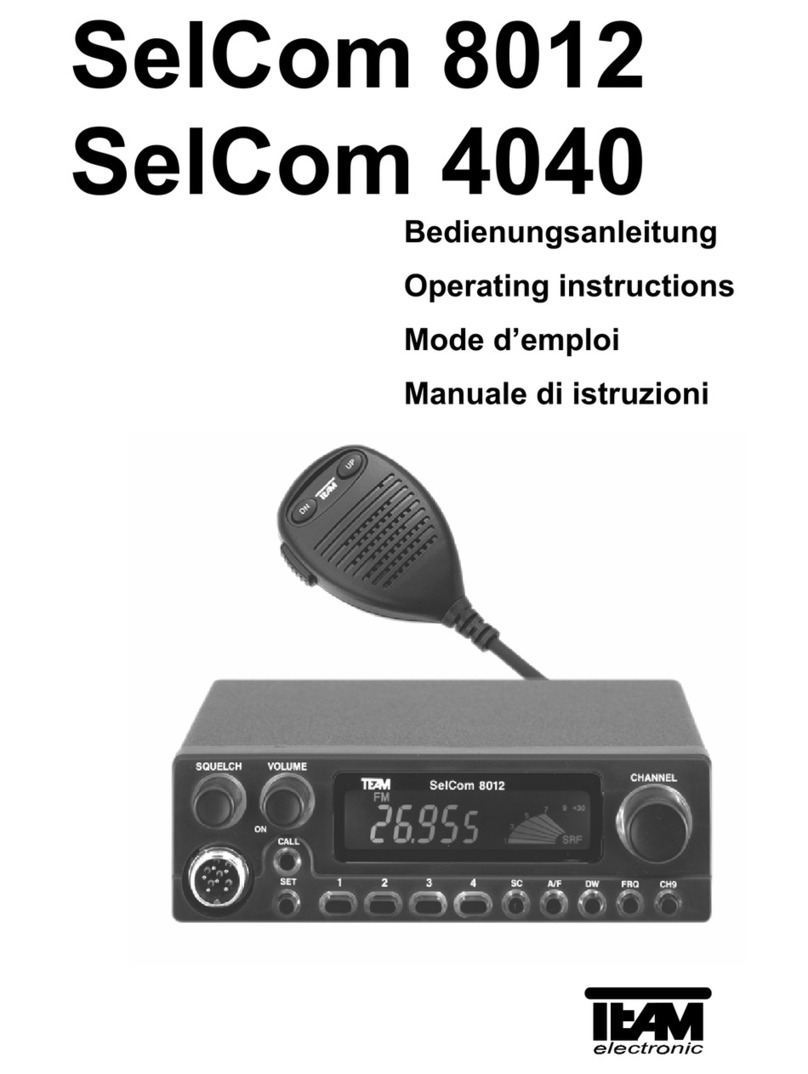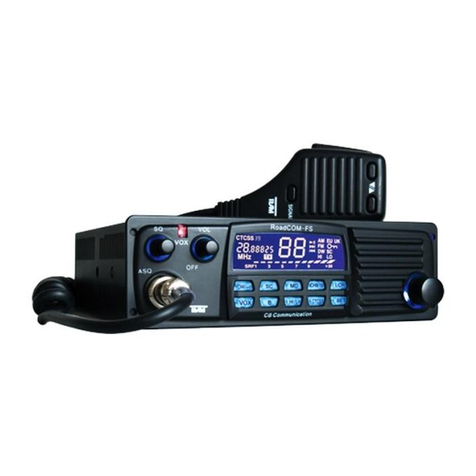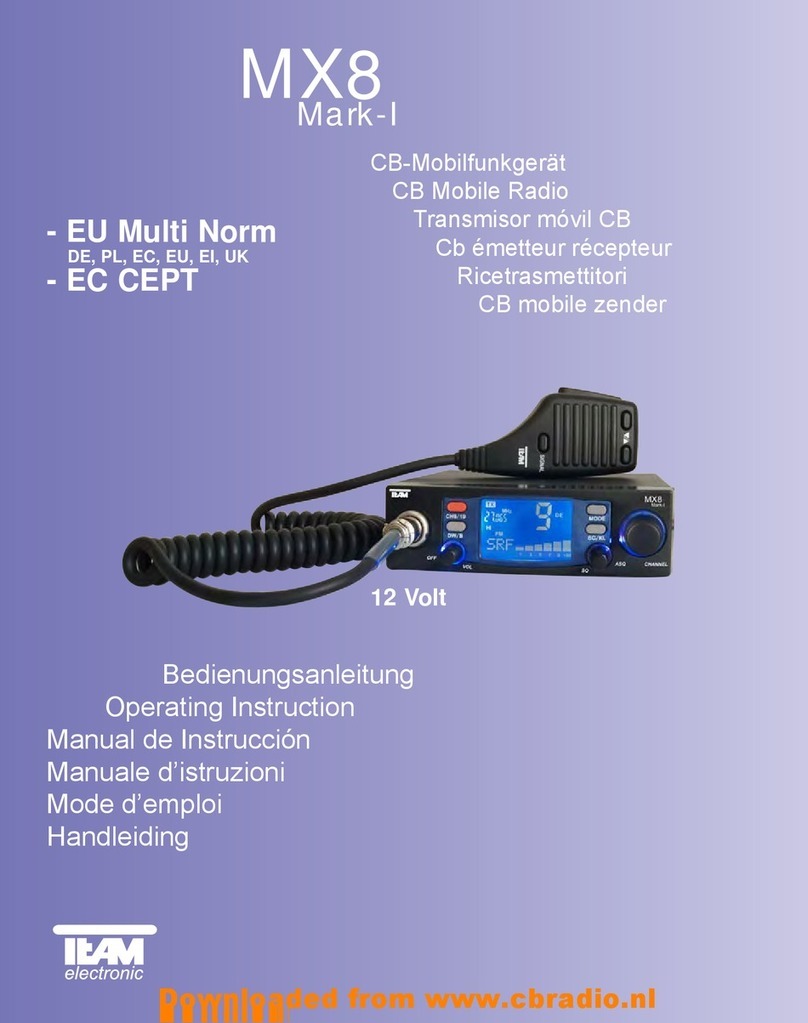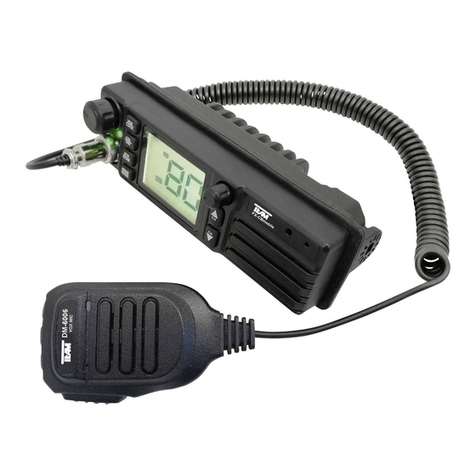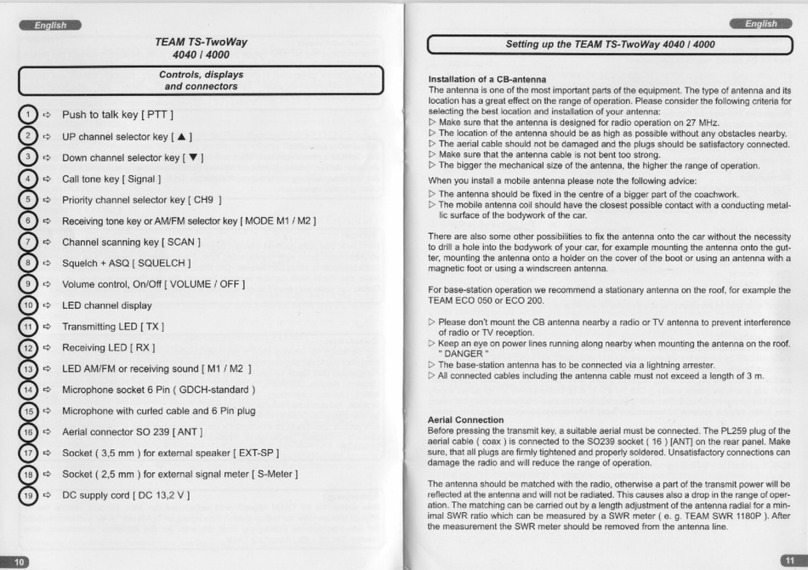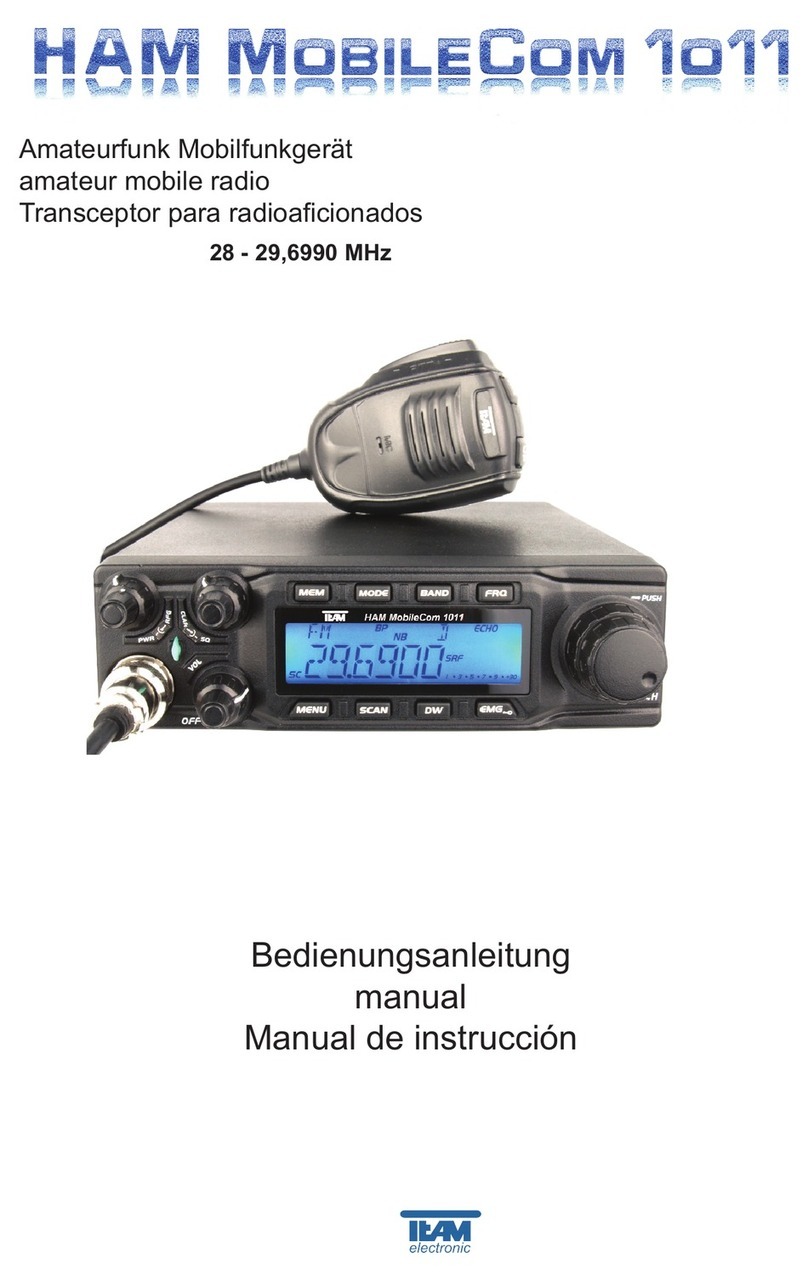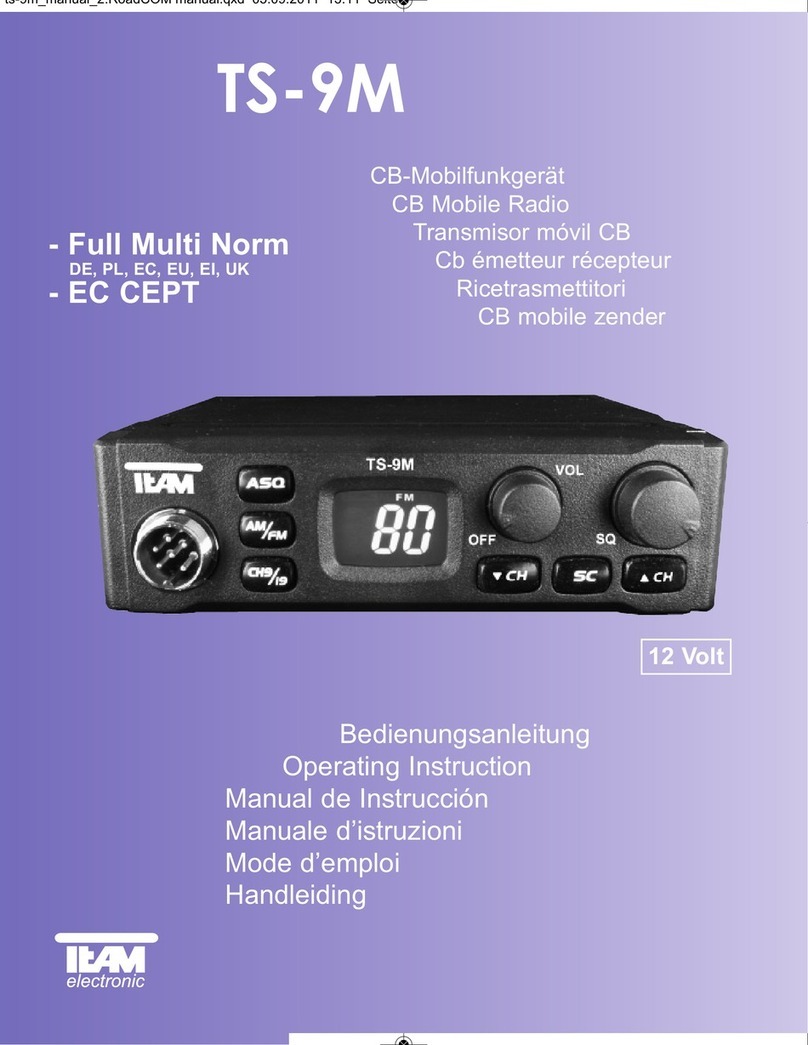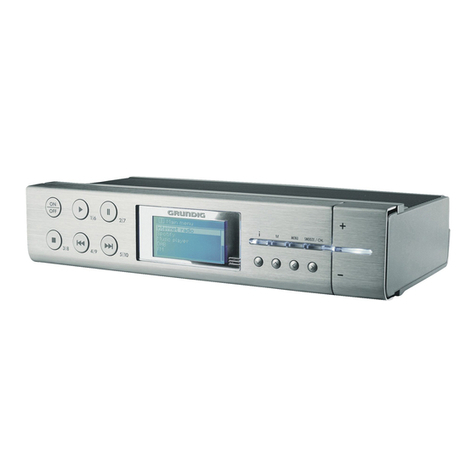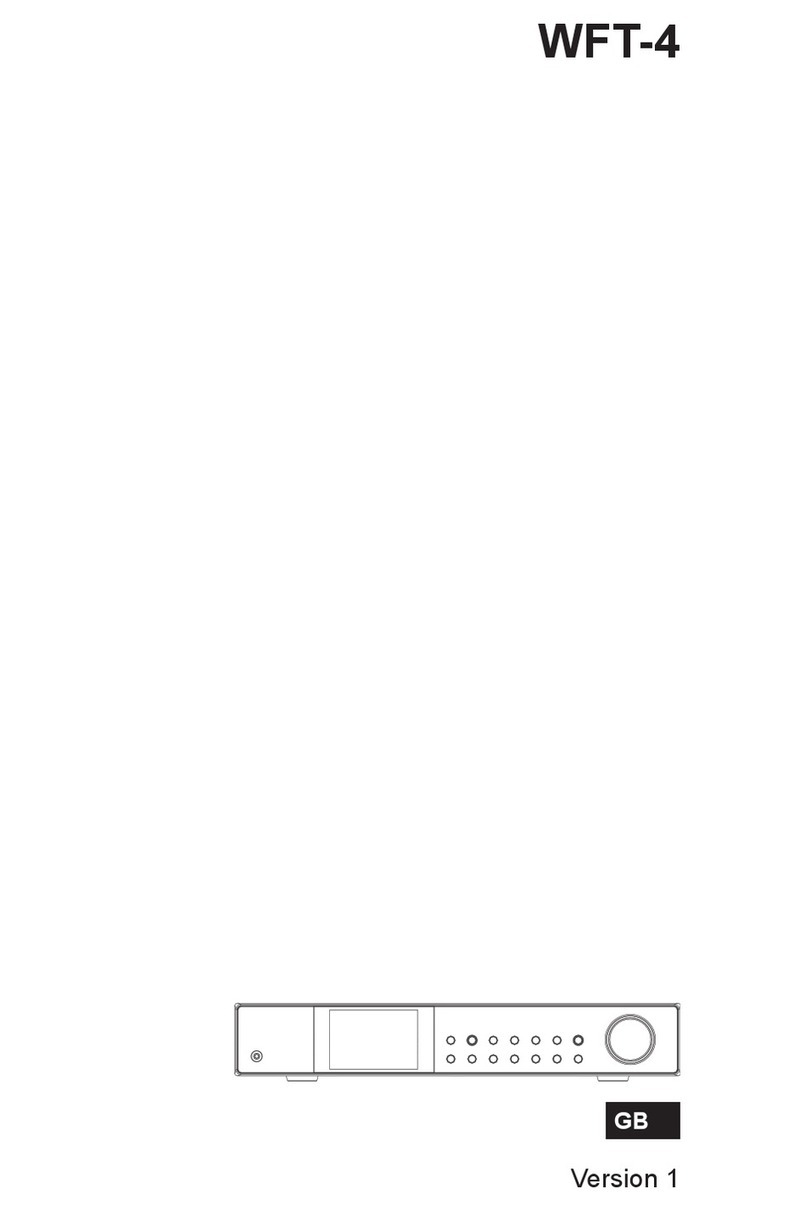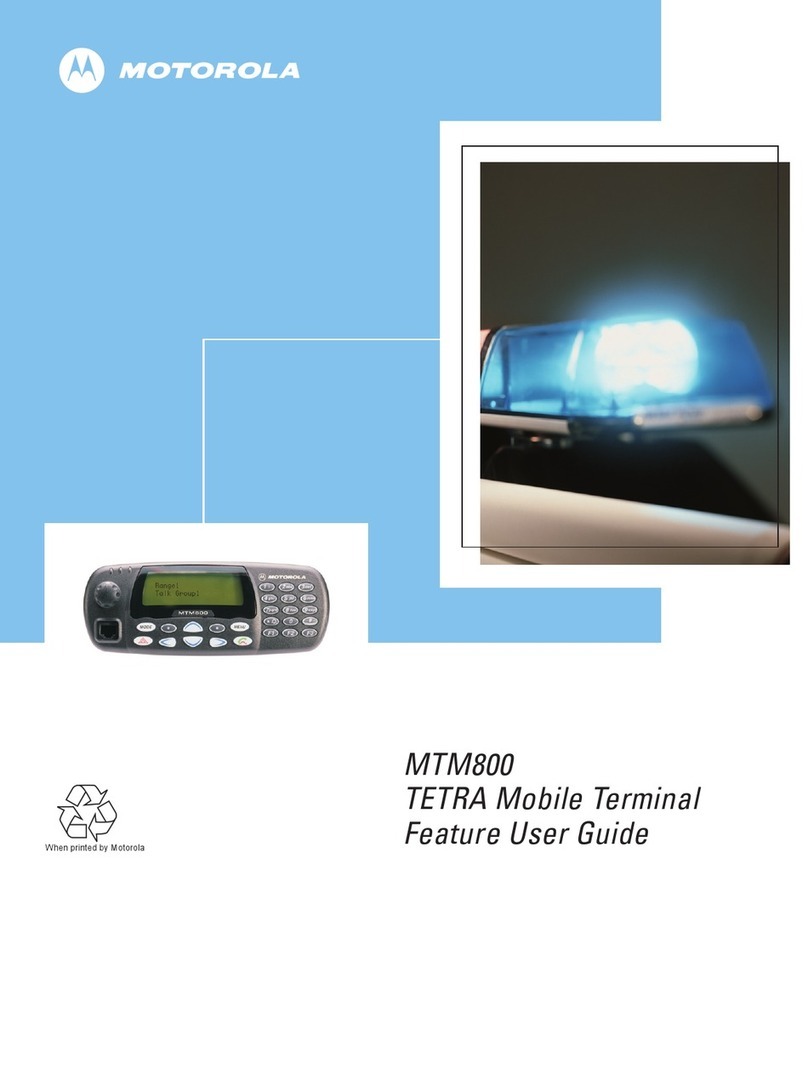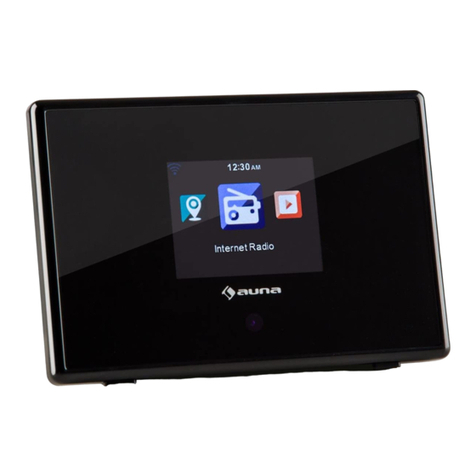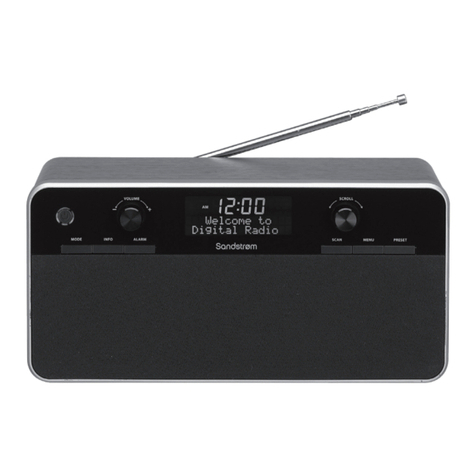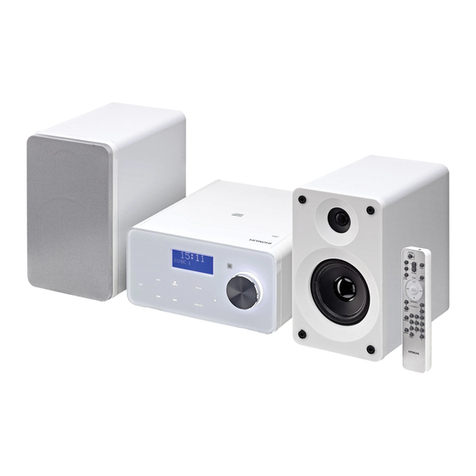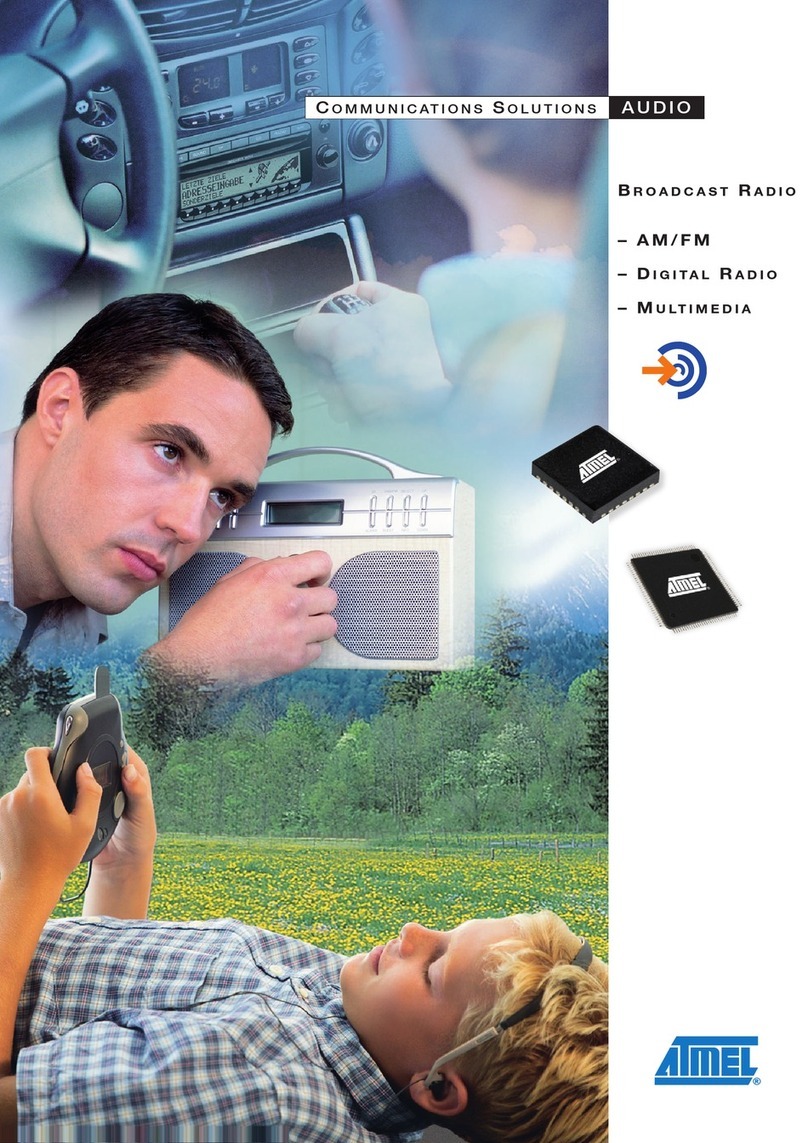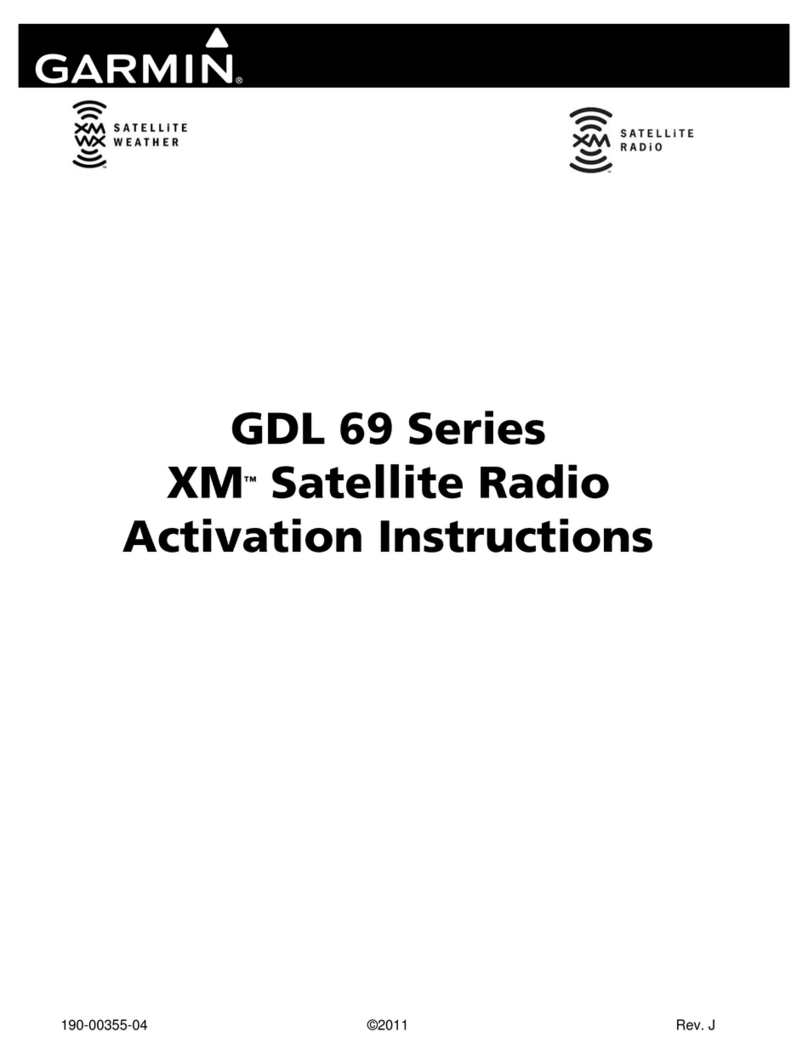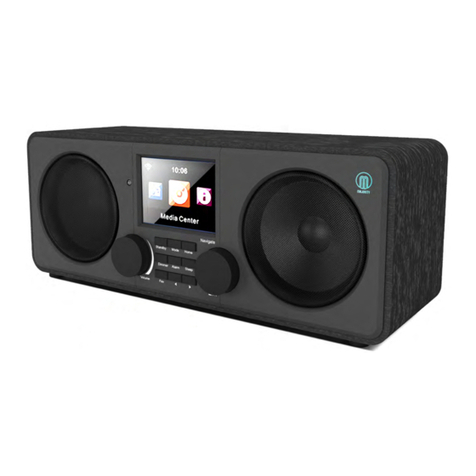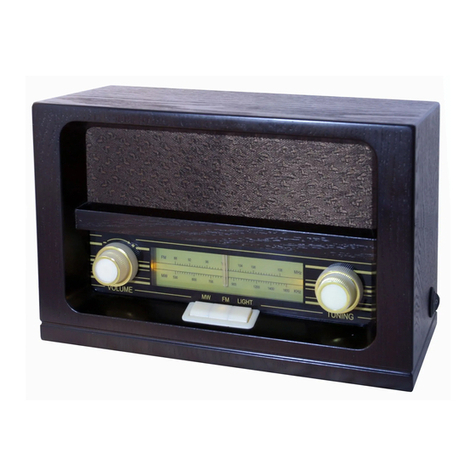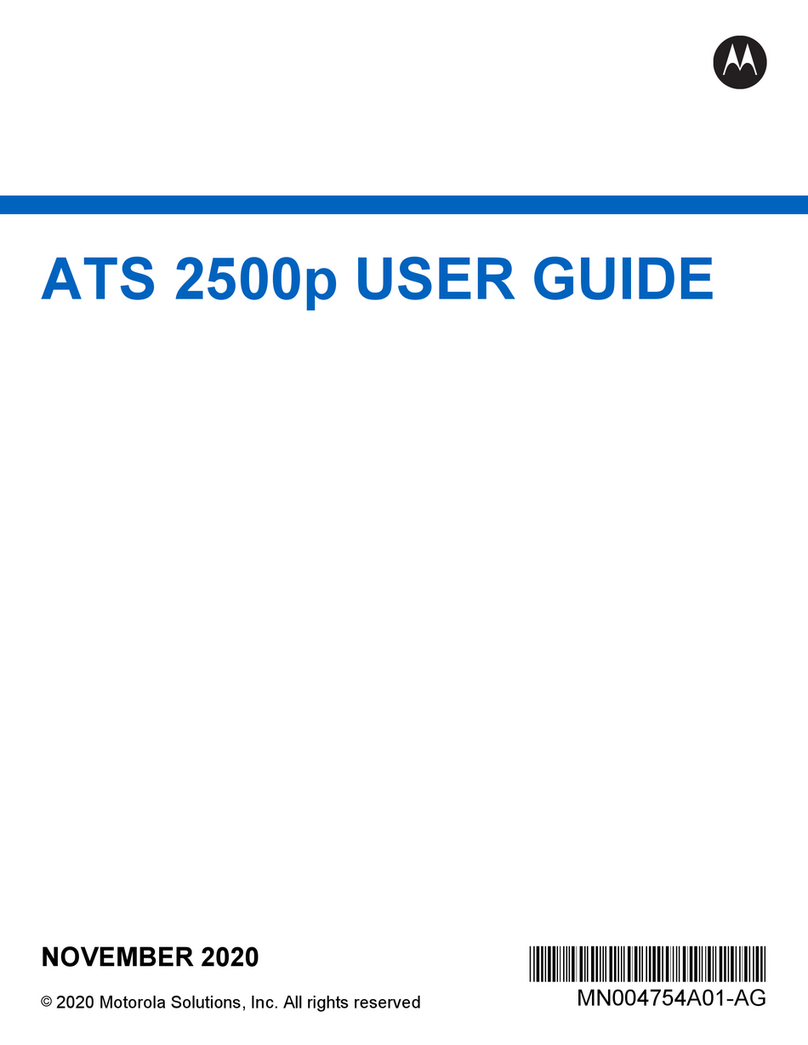Team TS-6M User manual

Bedienungsanleitung
Operating Instruction
Manual de Instrucción
Manuale d’istruzioni
Mode d’emploi
Handleiding
- Full Multi Norm
DE, PL, EC, EU, EI, UK
- EC CEPT
TS-6M
CB-Mobilfunkgerät
CB Mobile Radio
Transmisor móvil CB
Cb émetteur récepteur
Ricetrasmettitori
CB mobile zender
12 Volt
ts-6m_manual.qxp 06.01.2010 11:52 Seite 1

6
12
10
8
9
13
11
7
1 Micrófono con cable rizado y
conector 6 pin
2 Botón de selector canal / Arriba [ ]
3 Botón selector canal / Abajo [ ]
4 Botón pulsar para hablar [ PTT ]
5 Botón tono de llamada [ BP ]
6 Indicador LED
7 Selección de modulación [ Mode ]
8 Interruptor selector rotativo
de canal [ Channel ]
9 Interruptor de Squelch + Squelch
automático [SQ/ASQ ]
10 Control de volumen,
Encendido/Apagado [ Off / Vol ]
11 Control de sensibilidad de la
recepción [ RFG ]
12 Conector de micrófono 6 pin
( GDCH estándar)
13 Botón de prioridad canal 9 / 19
[ CH9 / 19 ]
14 Conector de antena aéreo
SO239
15 Cable de alimentación DC
16 Conector Jack ( 3,5 mm ) para
altavoces externos
Español página 24 - 29 Netherland pagina 42 - 48
1 Microfoon met spiraal kabel
en 6 pin plug
2 Kanaal selectie omhoog [ ]
3 Kanaal selectie omlaag [ ]
4 Push to talk toets [ PTT ]
5 Oproeptoon toets [ BP ]
6 LED display
7 Omschakelen van de
modulatie [ Mode ]
..8 Draai schakelaar voor de
kanalen [ Channel ]
9 Squelch bediening + automa-
tische squelch [ SQ / ASQ ]
10 Volume bediening, Aan/Uit
schakelaar [ Off / Vol ]
11 Gevoeligheidscontrole van
de ontvangst [ RFG ]
12 Microfoon aansluiting 6 pin
( GDCH standaard )
13 Kanaal 9 / 19 priority toets
[ CH9/19 ]
14 Antenne aansluiting SO239
15 DC kabel
16 Jack aansluiting ( 3.5 mm )
voor externe luidspreker
1 Mikrofon mit Spiralkabel +
6-Pol Stecker
2 Kanalwahltaste Aufwärts [ ]
3 Kanalwahltaste Abwärts [ ]
4 Sendetaste [ PTT ]
5 Rufsignaltaste [ BP ]
6 LED-Anzeige
7 Modulationsart [ Mode ]
8 Kanaldrehwahlschalter
[ Channel ]
9 Rauschsperreregler und
auto. Rauschsperre [ SQ/ASQ ]
10 Lautstärkeregler / Ausschalter
[ Off / Vol ]
11 Regler für Empfängerempfindlichkeit
[ RFG ]
12 Mikrofonanschlussbuchse
6polig,GDCH-Norm
13 Vorrangkanaltaste für Kanal 9 / 19
[ CH9 / 19 ]
14 Antennenanschlussbuchse
SO239
15 Stromversorgungskabel
16 Anschlussbuchse für externen
Lautsprecher 3,5 mm
Deutsch Seite 4 - 10
5
1
4
2
3
15
16
1 Microfono con cavo
spiralizzato e spina a 6 Pin
2 Tasto selettore canale UP []
3 Tasto selettore canale Down []
4 Tasto PTT [ PTT ]
5 Tasto segnale chiamata [BP]
6 Display LED
7 Selezione modalità [ Mode ]
8 Interruttore a rotazione per
selezione canale [ Channel ]
9 Regolazione Squelch +
Squelch automatico
[ SQ / ASQ ]
10 Regolazione volume + inter-
ruttore ON/OFF [ Off / Vol ]
11 Controllo di sensibilità
di ricezione [ RFG ]
12 Presa microfono a 6 Pin
(GDCH standard)
13 Tasto di canale 9 / 19
prioritario [ CH9/19 ]
14 Connettore SO239
15 Cavo alimentatore
16 Jack (3,5 mm.) per
altoparlante esterno
Italiano página 30 - 35 1 Microphone avec câble torsadé
et fiche 6 broches
2 Touche de sélection de canaux
vers le haut [ ]
3 Touche de sélection de canaux
vers le bas [ ]
4 Touche d'émission [ PTT ]
5 Touche de la tonalité [ BP ]
6 Afficheur du type LED
7 Touche de commutation du fonctionne-
ment AM/FM [ Mode ]
8 Sélecteur rotatif de canaux [Channel ]
9 Réglage et marche / arrêt du squelch et
squelch automatique [ SQ / ASQ ]
10 Réglage du volume et marche /
arrêt [ Off / Vol ]
11 Réglage de sensibilité de réception
[ RFG ]
12 Prise du microphone 6 broches
( standard GDCH )
13 Touche canal 9 / 19 prioritaire [ CH9/19 ]
14 Connecteur d'antenne SO239
15 Câble d'alimentation
16 Prise jack ( 3,5 mm ) pour un
haut-parleur externe
Français page 36- 41
1 Microphone with curled cable
and 6 pin plug
2 Channel selector key Up [ ]
3 Channel selector key
Down [ ]
4 Push to talk key [ PTT ]
5 Call tone key [ BP ]
6 LED display
7 Modulation [ Mode ]
8 Rotary channel selector
switch [ Channel ]
9 Squelch control and automatic
squelch [ SQ / ASQ ]
10 Volume control, On/Off switch
[ Off / Vol ]
11 Reception-sensitivity control
[ RFG ]
12 Microphone socket 6 pin
8 GDCH standard )
13 Channel 9 / 19 priority key
[ CH9 / 19 ]
14 Aerial connector SO239
15 DC power cable
16 Jack socket ( 3.5 mm ) for
external speaker
English page 12 - 17
14
ts-6m_manual.qxp 06.01.2010 11:52 Seite 2

Deutsch Inbetriebnahme des TEAM TS-6M
1) Montage einer CB-Funkantenne
Die Wahl der Antenne und des Montageortes ist von großer Bedeutung für die maximale
Reichweite Ihrer Funkanlage. Die folgenden Kriterien sollten Sie bei der Wahl des Anten-
nenstandortes und der Montage berücksichtigen.
Allgemein gilt :
> Die Antenne muss für den Funkbetrieb auf 27 MHz geeignet sein.
> Der Standort der Antenne sollte möglichst hoch und unverbaut sein.
> Das Antennenkabel muss unbeschädigt, und die Stecker ordnungsgemäß angeschlossen
sein.
> Das Antennenkabel darf nicht zu stark geknickt werden.
> Antennen mit einer größeren mechanischen Länge erzielen bessere Reichweiten.
Bei der Montage von Mobilantennen ist folgendes zu beachten:
> Die Antenne sollte in der Mitte eines größeren Karosserieteils montiert werden.
> Der Antennenfuß von Mobilantennen sollte möglichst guten Kontakt zu einer metallisch gut
leitenden Fläche des Karosseriebleches haben.
Außer der "festen Montage" einer Mobilantenne, bei der ein Loch in die Karosserie Ihres Fahr-
zeuges gebohrt werden muss, gibt es noch weitere Möglichkeiten, z. B. die Dachrinnen- oder
Kofferraumdeckel-Montage, sowie die Befestigung mit Magnetfuß oder Scheibenantenne.
Für den Aufbau einer Feststationsanlage empfiehlt sich die Montage einer stationären Dach-
antenne, z.B. TEAM ECO 050 oder ECO 200.
> Um Störungen bei Radio- und Fernsehempfang zu vermeiden, sollte die CB-Antenne nicht
in unmittelbarer Nähe einer Radio- oder Fernsehantenne montiert werden.
> Bei der Montage einer Dachantenne, ist auf in der Nähe verlaufende Hochspannungslei-
tungen zu achten. “LEBENSGEFAHR"
> Die Feststationsantenne muss über eine Blitzschutzeinrichtung angeschlossen werden.
>Alle angeschlossenen Leitungen, einschließlich derAntennenleitung, dürfen nur eine Länge
von max. 3 Metern haben.
2) Antennenanschluss
Der PL-Stecker (Typ PL259) des Antennenkabels (Koaxialkabel ) wird mit der Buchse ( 14 ) an
der Geräterückseite verbunden. Für eine einwandfreie Verbindung muss der Überwurf des
Steckers gut festgedreht werden. Ebenso ist auf eine ordentliche Verbindung des Antennen-
kabels mit dem Antennenfuß zu achten. Nicht einwandfreie Verbindungen können zu einem
Defekt des Gerätes führen und die Funkreichweite erheblich verringern. Die Antennenanlage
(nicht im Lieferumfang enthalten) sollte sehr gut an das Funkgerät angepasst sein, ansonsten
wird ein Teil der Sendeleistung an der Antenne reflektiert und nicht abgestrahlt. Das führt
ebenfalls zu einer geringeren Reichweite der Funkanlage. DieAnpassung derAntenne erfolgt
durch Längenabgleich des Antennenstrahlers bzw. seiner Anpassungsvorrichtung auf ein
minimales Stehwellenverhältnis, welches mit einem Stehwellenmessgerät (z.B. TEAM SWR
1180 P) gemessen werden kann. Das Stehwellenmessgerät muss nach der Messung wieder
aus der Antennenleitung entfernt werden.
Deutsch
INHALTSVERZEICHNIS
Inbetriebnahme des TEAM TS-6
1) Montage einer CB-Funkantenne 5
2) Antennenanschluss 5
3) Montage des Gerätes im Fahrzeug 6
4) Mikrofon DM-906T 6
5) Stromversorgung 6
Funkbetrieb mit dem TEAM TS-6M
1) Einschalten [ Off / Vol ] 7
2) Rauschsperre [ SQ / ASQ ]7
3) Kanalwahl [ ] [ ]7
4) Umschaltung der Modulationsarten [ Mode ] 7 - 8
5) Umschaltung der Normen 8
6) Senden 8
7) Rufsignal 9
8) Vorrangkanal 9/19 [ CH9/19 ] 9
9) Empfangsempfindlichkeit [ RFG ]9
10) Signal-Meter 9
11) Anschlussbuchse für einen externen Zusatzlautsprecher 9
Hinweise
1) Sicherheitshinweis 10
2) Allgemeine Hinweise 10
3) Service 10
4) Konformität 10
5) Entsorgung 10
Kanalfrequenztabelle 18
Technische Daten 19
Schaltpläne 20 - 23
4 5
ts-6m_manual.qxp 06.01.2010 11:52 Seite 4

Funkbetrieb mit dem TEAM TS-6M
1) Einschalten [ Off / Vol ]
Zum Einschalten des Gerätes, den Lautstärkeregler ( 10 ) [ Off / Vol ] nach rechts drehen.
Um die Lautstärke optimal anzupassen, sollte der Rauschsperreregler ( 9 ) [ SQ / ASQ ] fast bis
zum Linksanschlag gedreht werden, kurz vor dem automatischen Umschalten von manueller zu
automatischer Rauschsperre. Es ertönt ein Rauschen. Stellen Sie nun die gewünschte Laustär-
ke ein.
Alle Einstellungen, die beim Betrieb des Gerätes vorgenommen werden, bleiben nach dem
Ausschalten erhalten, solange die Stromversorgung nicht unterbrochen wird.
2) Rauschsperre [ SQ / ASQ ]
Das störende, andauernde Rauschen, das immer auf freien Kanälen auftritt, kann mit Hilfe der
Rauschsperre unterdrückt werden. Das Gerät vefügt über eine automatische (ASQ) und eine
manuelle Rauschsperre (SQ).
Die automatische Rauschunterdrückung ist intern auf einen fixierten Mittelwert eingestellt und
wird durch Drehen des Rauschsperrenregelers ( 9 ) [ SQ / ASQ ] ganz nach links aktiviert. Das
Ein-bzw. Ausschalten der automatischen Rauschunterdrückung wird akustisch durch einen
Doppeltton bestätigt. In derAnzeige wird der aktivierte Zustand der automatischen Rauschsper-
re durch zwei Punkte unterhalb der Kanalziffer bestätigt.
Um die manuelle Rauschunterdrückung zu aktivieren, drehen Sie bitte den Rauschsperrereg-
ler ( 9 ) [ SQ / ASQ ] zuerst ganz nach links, bevor sie dann den Regler langsam nach rechts
drehen bis ein Doppelton das Umschalten zur manuellen Rauschunterdrückung bestätigt. Die
in der automatischen Rauschunterdrückung angezeigten zwei Punkte in der Anzeige ver-
schwinden im Modus der manuellen Rauschunterdrückung.
Der Regler sollte nur soweit über den Stummschaltepunkt gedreht werden, bis das Rauschen
sicher unterdrückt ist. Wenn eine Station auf dem Kanal sendet, öffnet die Rauschsperre, und
das Signal ist hörbar. Bei zu kritischer Einstellung der Rauschsperre kann ab und zu ein kurzes
Rauschen auftreten, ohne dass sich eine Station auf dem Kanal befindet. Weiteres Rechtsdre-
hen unterdrückt zunehmend schwache Stationen, aber auch stärkere Störsignale.
3) Kanalwahl [ ] [ ]
Die Kanäle können durch Drücken der Kanalwahltasten ( 2 ) [ ] und ( 3 ) [ ] am Mikrofon
oder mit dem Kanalwahldrehschalter ( 8 ) eingestellt werden. In der LED Anzeige ( 6 ) wird die
Kanalnummer dargestellt. Während des Sendens kann kein anderer Kanal eingestellt wer-
den. Die Kanalnummern werden ringförmig durchlaufen, so dass die Kanäle abwärts zählend
von 1 auf 40 bzw. 80, und aufwärts zählend von 80 bzw. 40 auf 1 übergangslos gewählt wer-
den können. Es kann nur auf übereinstimmenden Kanalnummern und Modulationsarten mit
der Gegenstation Funkbetrieb aufgenommen werden.
4) Umschaltung der Modulationsarten [ Mode ]
Das TS-6M arbeitet in den ModulationsartenAM und FM. In der VersionTS-6M c (EC CEPT)
und in der Norm EC der Version TS-6M Full Multi Norm steht nur die Betriebsart FM zur Ver-
fügung. Falls das Gerät auf dem aktuellen Kanal auch die Betriebsart AM akzeptiert, können
Sie es durch Drücken der Taste ( 7 ) [ Mode ] zwischenAM und FM hin- und herschalten. Die
3) Montage des Gerätes im Fahrzeug
Das Gerät kann mit dem beiliegenden Montagebügel-Set z.B. unter dem Armaturenbrett
befestigt werden. Bei der Wahl der optimalen Position für die Montage des Gerätes in Ihrem
Fahrzeug sind auch die folgenden Kriterien zu berücksichtigen:
> keine Beeinträchtigung der Verkehrssicherheit,
> gute Erreichbarkeit der Bedienelemente,
> ausreichende Luftzirkulation, um eine Überhitzung des Gerätes im Sendefall zu verhindern.
Darüber hinaus sollten Sie auch sicherstellen, dass die LCD-Kanalanzeige ( 6 ) gut ablesbar
ist. Bei direkter Sonneneinstrahlung kann die Lesbarkeit der Anzeige beeinträchtigt werden.
Die günstigste Montageposition sollte vor dem endgültigen Einbau überprüft werden. Mit Hilfe
des beiliegenden Montagebügels, ist eine schnelle Montage bzw. Demontage an verschiede-
nen Stellen im Fahrzeug möglich.
4) Mikrofon DM-906T
Das Mikrofon ( 1 ) wird mit dem 6poligen Stecker in die Mikrofonbuchse ( 12 ) an der linken
Gerätefrontseite angeschlossen. Ohne Mikrofon ist kein Sende- oder Empfangsbetrieb mög-
lich. Die Mikrofonbuchse ist nach GDCH-Standard angeschlossen:
PIN 1 Modulation PIN 2 Lautsprecher
PIN 3 PTT PIN 4 Up/Down
PIN 5 Masse PIN 6 +12 Volt
Mit dem TS-6M wird das Standardmikrofon DM-906T mit Kanalwahl und Rufsignal mitgelie-
fert. Dieses Mikrofon ist optimal für das TS-6M geeignet.
5) Stromversorgung
Vor dem Anschluss der Stromversorgung schalten Sie das Gerät aus, indem Sie den Laut-
stärkeregler ( 10 ) [ Off / Vol ] bis zum Einrasten nach links drehen.
Verbinden Sie die beiden blanken Anschlüsse am Ende des Kabels mit dem 12 V Bord-
netz Ihres Fahrzeuges. Das Stromversorgungskabel sollte möglichst weit von störenden
Aggregaten verlegt werden. Achten Sie beim Anschluss auf die richtige Polarität:
SCHWARZ wird mit "-" ( = MINUS / Masse ) des KFZ verbunden.
ROT wird mit "12 Volt +" ( = PLUS ) des KFZ/LKW-Bordnetzes verbunden.
Bei Verwendung von Dauerplus bleiben die letzten Einstellungen auch nach dem Ausschal-
ten des Gerätes und dem Abstellen des Motors gespeichert.
Mit einem geeigneten Netzteil ( 13,2 V / 2,5 A ), z.B. aus der TEAM Serie LabNT, kann das
Gerät auch als Feststation betrieben werden. Bei dem Kauf eines Netzteils sollten Sie darauf
achten, dass es für den Anschluss eines Funkgerätes geeignet ist. Bei ungeeigneten Netz-
teilen kann im Sendebetrieb die Betriebsspannung stark ansteigen, und/oder Störungen im
Sende- und Empfangsbetrieb durch Netzbrummen auftreten.
Nachdem dieAntenne, das Mikrofon und die Stromversorgung sorgfältig angeschlossen sind,
kann der Funkbetrieb aufgenommen werden.
Deutsch Deutsch
6 7
Ansicht von der Lötseite der
Mikrofonbuchse bzw. Vorderan-
sicht des Mikrofonsteckers
ts-6m_manual.qxp 06.01.2010 11:52 Seite 6

Betriebsart AM wird mit der grünen LED und die Betriebsart FM mit der orangen LED ange-
zeigt. Falls das TS-6M die Betriebsart AM nicht akzeptiert, ertönt nur ein Quittungston, aber
das Symbol FM bleibt in der Anzeige. Falls Sie sich auf einem Kanal in der Betriebsart AM
befinden und auf einen Kanal wechseln, auf dem die Betriebsart AM nicht akzeptiert wird,
erfolgt eine Zwangsumschaltung auf FM. Bei einem weiteren Wechsel auf einen Kanal, auf
dem die BetriebsartAM wieder akzeptiert wird, springt die Betriebsart automatisch wieder auf
AM zurück.
Hinweis für die Norm UK:
In der Norm UK zeigen die orange und grüne LED das gewählte FM-Frequenzband EU oder
UK an und nicht die Betriebsart AM bzw. FM. Die Norm UK verfügt über 40 Kanäle FM UK
(27,60125 - 27,99125 MHz) und 40 Kanäle FM EU (26,965 - 27,405 MHz).
5) Umschaltung der Normen
Die Geräteversion "TS-6M Multi Norm" kann vom Benutzer auf eine der folgenden Normen
eingestellt werden:
Norm Kanäle und Frequenzen Anzeige
DE 80 FM (26,565 - 27,405 MHz), 4 W / 40 AM (26,965 - 27,405 MHz), 1 W d
UK 40 FM (27,60125 - 27,99125 MHz), 4 W / 40 FM (26,965 - 27,405 MHz), 4 W U
EI 40 FM (26,965 - 27,405 MHz), 4 W / 40 AM (26,965 - 27,405 MHz), 4 W Ei
EU 40 FM (26,965 - 27,405 MHz), 4 W / 40 AM (26,965 - 27,405 MHz), 1 W EU
EC 40 FM (26,965 - 27,405 MHz), 4 W EC
PL 40 FM (26,960 - 27,400 MHz), 4 W / 40 AM (26,960 - 27,400 MHz), 4 W PL
Zum Einstellen bzw. Umschalten der Normen halten Sie bitte den Modulationarten-Umschal-
ter ( 7 ) [ Mode ] während dem Einschalten des Gerätes gedrückt. In der Anzeige erscheint
blinkend das Kürzel der aktuellen Norm. Alle anderen Symbole sind nicht sichtbar. Die
gewünschte Norm wird durch Drücken des Modulationarten-Umschalter ( 7 ) [ Mode ] einge-
stellt. Zum Bestätigen der Norm das Gerät kurz aus- und wieder einschalten.
Für die Erlaubnis und die Auflagen zum Betrieb der verschiedenen Normen in den einzelnen
Ländern sehen Sie in den Gerätepass. Der Benutzer ist für die richtige Einstellung der gülti-
gen Norm im jeweiligen Land eigenverantwortlich.
Hinweis:
Die Ausführung TS-6M c (EC CEPT) ist intern fest auf 40 Kanäle FM, 4 Watt eingestellt und
somit für den Betrieb in Österreich geeignet.
6) Senden
Zum Senden wird die im Mikrofon (1) eingebaute Sendetaste (4) [ PTT ] gedrückt und für die
Dauer der Durchsage gehalten. In dieser Zeit leuchtet die rote Sendekontroll-LED in der
Anzeige und die relative Sendeleistung wird angezeigt.
Sprechen Sie in das Mikrofon aus ca. 5 cm Entfernung mit normaler Lautstärke. Zu lautes
oder zu leises Besprechen vermindert die Signalqualität. Nach Beendigung der Durchsage
die Sprechtaste ( 4 ) [ PTT ] loslassen. Das Gerät schaltet automatisch in den Empfangsbe-
trieb zurück.
Außer der Rufsignaltaste ( 5 ) [ BP ], sind die Bedienelemente während des Sendens gesperrt.
7) Rufsignal
Werden am Mikrofon ( 1 ) die PTT-Taste ( 4 ) und die Rufsignaltaste ( 5 ) [ BP ] gleichzeitig
gedrückt, wird ein Rufsignal ausgesendet. Der Rufton ist nur in der Gegenstation zu hören,
vorausgesetzt diese ist auf den gleichen Kanal und die gleiche Betriebsart eingestellt.
8) Vorrangkanal 9 / 19 [ CH9/19 ]
Das Gerät verfügt über die Vorrangkanäle 9 und 19. Durch einmaliges Drücken der Vorrang-
kanaltaste ( 13 ) [ CH9/19 ] wird Kanal 9 eingestellt. Zum Einstellen von Kanal 19, die Vor-
rangkanaltaste zwei Mal Drücken.
9) Empfangsempfindlichkeit [ RFG ]
Signale, die aus unmittelbarer Nähe empfangen werden, können unter Umständen zu stark
sein - das Signal verzerrt.
Es ist von Vorteil sehr starke Signale abzuschwächen, da diese unter Umständen wegen
starker Verzerrung schlecht verständlich sein können. Mit dem RFG-Regler [ RFG ] ( 11 )
wird die Empfangssignalstärke reduziert durch Schwächung der Empfangsempfindlichkeit.
Keine Signal-Dämpfung erfolgt wenn der Regler bis zumAnschlag im Uhrzeigersinn gedreht
ist. Dies sollte für den normalen Betrieb die Standardeinstellung sein. Zunehmendes Dre-
hen entgegen dem Uhrzeigersinn verringert die Empfangsempfindlichkeit.
10) Internes Signal-Meter
Die Empfang- und Sende-Signalstärke wird durch eine 5-teilige Balkenanzeige dargestellt.
Das Erreichen der vollen Feldstärke wird durch Leuchten der roten LED anzeigt.
11) Anschlussbuchse für einen externen Zusatzlautsprecher
Das TS-6M hat an der Geräterückseite eine Klinkenbuchse ( 16 ) ( 3,5 mm ø ) zum
Anschluss für einen externen Lautsprecher mit 4 - 8 Ohm Impedanz ( z.B. TEAM TS-500 ).
Bei Anschluss des externen Lautsprechers wird der interne Lautsprecher abgeschaltet. Bei
4 Ohm sollte die Belastbarkeit des Lautsprechers 4 Watt betragen.
DeutschDeutsch
8 9
ts-6m_manual.qxp 06.01.2010 11:52 Seite 8

Deutsch Deutsch
11
HINWEISE
1) Sicherheitshinweis
Bitte beachten Sie als KFZ-Fahrer beim Funkbetrieb auch die Bestimmungen der jeweils gülti-
gen Straßenverkehrsordnung. Bei dem Betrieb des Gerätes wird Hochfrequenzenergie freige-
setzt. Es muss daher ein entsprechender Sicherheitsabstand zur Antenne eingehalten werden.
2) Allgemeine Hinweise
Das Gerät ist vor Feuchtigkeit und Staub zu schützen. Das Gerät niemals an Orten aufbe-
wahren, die einer starken Erhitzung und/oder direkter Sonneneinstrahlung ausgesetzt sein
könnten. Zur Gehäusereinigung ein weiches, fusselfreies Tuch verwenden. Zur Reinigung
niemals Lösungsmittel verwenden.
3) Service
Das Gerät darf nicht geöffnet werden. Eigenhändige Reparaturen oder Abgleich sind nicht
vorzunehmen, denn jede Veränderung, bzw. Fremdabgleich, können zum Erlöschen der
Betriebserlaubnis sowie der Gewährleistungs- und Reparaturansprüche führen. Bei Betriebs-
störungen sollte das Gerät nicht benutzt werden. Trennen Sie in diesem Fall die Stromver-
sorgung ab. Liegt ein Defekt vor, sollte auf jeden Fall der autorisierte TEAM-Fachhändler kon-
taktiert werden.
4) Konformität
TEAM TS-6M
Das CB-Mobilsprechfunkgerät TEAM TS-6M entspricht der europäischen R&TTE Direktive
und hält die europäischen Normen EN 300 135-1/-2, EN 300 433-2, EN 301 489-1/-13 und
EN 60950-1 ein. Die genauen Länderbestimmungen der verschiedenen Versionen entneh-
men Sie bitte dem beiliegenden Gerätepass.
5) Entsorgung
Bitte werfen Sie Ihr TEAM-Altgerät nicht einfach auf den Müll, sondern senden Sie Ihr Altge-
rät bitte portofrei zur fachgerechten Entsorgung an TEAM ein. TEAM wird anschließend die
umweltschonende Entsorgung Ihres Altgerätes für Sie kostenlos veranlassen. Bitte machen
Sie mit - der Umwelt zuliebe.
- Änderung der technischen Daten und der Ausführung sind ohne Vorankündigung vorbehalten. -
10
ts-6m_manual.qxp 06.01.2010 11:52 Seite 10

English English
Setting up the TEAM TS-6M
1) Installation of a CB antenna
The antenna is one of the most critical parts in the setup. The type of antenna and its loca-
tion has a great effect on the range of operation. Please consider the following criteria for
selection of the best location and installation of your antenna:
> Make sure that the antenna is designed for radio operation on 27 MHz.
> The location of the antenna should be as high as possible without any obstacles nearby.
> The aerial cable should not be damaged and the plugs should be properly connected.
> Make sure that the antenna cable is not bent.
> The bigger the mechanical size of the antenna, the higher the range of operation.
When you install a mobile antenna please note the following advices:
> The antenna should be fixed in the center of a big body-part, e.g. the trunk.
> The mobile antenna coil should have the closest possible contact with a conducting metallic
surface of the bodywork of the car.
There are also some other possibilities to fix the antenna onto the car without the necessity
to drill a hole into the bodywork of your car, e.g. mounting the antenna onto the gutter, mount-
ing the antenna onto a holder on the cover of the boot or using an antenna with a magnetic
foot or using a windscreen antenna.
For base-station operation we recommend a stationary antenna on the roof, for example the
TEAM ECO 050 or ECO 200.
> Please don't mount the CB antenna nearby a radio or TV antenna to prevent interference
of radio or TV reception.
> Keep an eye on power lines running along nearby when mounting the antenna on the roof.
" DANGER "
> The base-station antenna has to be connected via a lightning arrester.
> All connected cables including the antenna cable must not exceed a length of 3 m.
2) Aerial Connection
Before pressing the transmit key, a suitable aerial must be connected. The PL259 plug of the
aerial cable ( coax ) is connected to the SO239 socket ( 14 ) on the rear panel. Make sure,
that all plugs are firmly tightened and properly soldered. Insufficient connections can damage
the radio and will reduce the range of operation.
The antenna should be matched with the radio, otherwise a part of the transmit power will be
reflected at the antenna and will not be radiated. This reduces the range of operation. The
matching of antenna to radio, is performed by a length adjustment of the antenna radial in
aim for a minimal SWR ratio which can be measured by a SWR meter,e.g. TEAM SWR
1180P. After the measurement the SWR meter should be removed from the antenna line.
3) Installation in the car
When you want to fix the unit in your car, you can either fasten it with the help of the includ-
ed mounting bracket below the dashboard. Always mount the transceiver where the switch-
es are easily accessible. Other important points to consider for a correct mounting position
are:
TABLE OF CONTENTS
Setting up the TEAM TS-6M
1) Installation of a CB antenna 13
2) Aerial Connection 13
3) Installation in the car 13 - 14
4) Microphone DM-906T 14
5) Power source 14
Operation of the TEAM TS-6M
1) Switching on [ Off / Vol ] 15
2) Squelch [ SQ / ASQ ] 15
3) Channel selection [ ] [ ]15
4) Modulation selection [ Mode ] 15 - 16
5) Norm selection 16
6) Transmitting 16
7) Call tone 16
8) Priotitiy Channels 9 / 19 16
9) Receipt-Signal Sensitivity [ RFG ]17
10) Signal meter 17
11) External signal meter jack 17
Additional Information
1) Safety Instructions 17
2) General Precautions 17
3) Servicing 17
4) Conformity 17
Channel Frequencies 18
Specifications 19
Schematic Diagram & PCB layout 20 - 23
12 13
ts-6m_manual.qxp 06.01.2010 11:52 Seite 12

> no interference of the roadworthiness,
> good access to the controls of the car,
> sufficient air circulation to prevent overheating of the radio in transmit mode.
Please consider the perspective onto the display while driving. Starting from a certain angle
of view, the readability of the display diminishes. An intensive solar irradiation can also affect
the readability of the display. So it is recommended to check the best position before the final
installation. The unit can easily be fixed onto different positions in the car by using the enclo-
sed mounting bracket.
4) Microphone DM-906T
Plug the microphone ( 1 ) into the 6 pin socket ( 12 ) on the front panel. Note it will only go in
one way round. No transmission and receiving is possible without the microphone. The pin
assignment of the GDCH standard microphone plug is given below:
PIN 1 Modulation
PIN 2 Loudspeaker
PIN 3 PTT
PIN 4 Up/Down
PIN 5 Ground
PIN 6 +12 Volt
Solder side view of the microphone connector or top view of the microphone plug.
The standard microphone DM-906T, which is equipped with channel selection and signal
tone, is included with the TS-6M. This microphone is the best selection for the TS-6M.
5) Power source
Before connecting the unit to a suitable power source via the fused DC power cable (15), the
device must be switched off by turning the volume control ( 10 ) [ Off / Vol ] counterclockwi-
se to the very end until a clicking sound is heard.
Then, connect the two naked leads at the end of the cable with the supply voltage of the
car/lorry battery. The unit is designed to operate with 12 volts and a negative ground electri-
cal system. Lay the cable as far as possible away from aggregates which can cause interfe-
rence. Watch for the correct polarity during the connection.
BLACK connect to - MINUS / ground of the car battery.
RED connect to 12 volts + PLUS of the car/lorry battery.
If the power source is not disconnected after putting the engine off, the last settings will
remain stored, after the unit and the car are switched off.
For base-station operation use a suitable power supply (13.2 V / 2.5 A, e. g. TEAM LabNT
series). The power supply should be designed for operation with a transceiver, otherwise
interference from the mains or over-voltage may occur.
After proper connection of the microphone, the aerial and power source, radio operation can
be started.
Operation of the TEAM TS-6M
1) Switching on [ Off / Vol ]
To turn on the radio, turn the On / Off switch ( 10 ) [ Off / Vol ] clockwise.
With the help of the squelch control ( 9 ) [ SQ / ASQ ], you can set a comfortable volume level.
Set the manual squelch (SQ) to a level where the constant noise of an empty channel is audi-
ble - see 2) Squelch. Now, adjust the volume level.
The memory function of the radio will set the last used norm, frequency band and channel after
turning the radio off and then back on, as long as the power supply is not disrupted.
2) Squelch [ SQ / ASQ ]
The strong background noise, which occurs always on free channels, can be suppressed by
the squelch function, which has an automatic and a manual mode.
By turning the squelch control ( 9 ) [ SQ / ASQ ] slowly clockwise you will find a point where
the noise disappears. The squelch control should only be turned up far enough to stop the
background noise on an unused channel. Turning the control further clock-wise will increas-
ingly suppress stronger interfering signals as well as weak stations.
The automatic squelch [ ASQ ] ( 9 ) uses a preset average value. It can be activated by turn-
ing the squelch control counterclock-wise all the way to the end. This is confirmed by a dou-
ble-tone. The automatic squelch mode is indicated in the display by two points, located below
the channel number.
3) Channel selection [ ] [ ]
All channels can be selected by pushing the channel selector keys ( 2 ) [ ] and ( 3 ) [ ]
at the microphone or by turning the rotary channel selector ( 8 ) [ Channel ] on the front panel
of the radio. The selected channel is displayed on the LCD ( 6 ). No channel selection is pos-
sible while the radio is in TX mode. The channels are arranged in a consecutive order, in a
ring-like-system, i.e. after the highest channel number it starts again with channel no. 1 and
vice versa. For communication with a partner CB station, both transceivers must be adjusted
to the same channel and the same modulation type.
4) Modulation selection [ Mode ]
For the TS-6M, the operating modes AM and FM are available. However, the version TS-6M c
(EC CEPT) and the norm EC of the the version TS-6M Full Multi Norm operate in FM only.
The AM mode is indicated by a green LED. For FM mode, the orange LED lights. To toggle bet-
ween the modes press the mode key ( 7 ) [ Mode ].
If the selected norm does not accept the modulation typeAM on the actual channel, you will hear
a receipt tone, but it remains on the modulation type FM.
If the radio is set to AM on the actual channel, and you select another channel, on which the
AM mode is inhibited, the modulation changes automatically to FM mode. If you select once
more another channel, on which the AM mode is allowed again, the modulation switches
automatically to back to AM mode.
With the version TS-6M Full Multi Norm in the norm UK, you can toggle between the EU
band and the UK band, which is indicated by symbol "EU" or "UK", by pressing the key ( 7 )
[ Mode ]. The CB band EU consists of the 40 CEPT channels. The CB band UK consists of
English English
14 15
ts-6m_manual.qxp 06.01.2010 11:53 Seite 14

40 channels starting from 27.60125 MHz to 27.99125 MHz. The selection UK is indicated by
the orange LED, while the selection EU is indicated by the green LED.
After turning the radio off, the TS-6M stores the last channel and the band, as long as the
power source remains connected.
5) Norm Selection
The version TS-6M Full Multi Norm can be set by the user to the following norms:
DE 80 FM
(26.565 - 27.405 MHz), 4 W / 40 AM (26.965 - 27.405 MHz), 1 W
EU 40 FM (26.965 - 27.405 MHz), 4 W / 40 AM (26.965 - 27.405 MHz), 1 W
EC 40 FM (26.965 - 27.405 MHz), 4 W
UK 40 FM (27.60125 - 27.99125 MHz), 4 W / 40 FM (26.965 - 27.405 MHz), 4 W
PL 40 FM (26.960 - 27.400 MHz), 4 W / 40 AM (26.960 - 27.400 MHz), 4 W
EI 40 FM (26.965 - 27.405 MHz), 4 W / 40 AM (26.965 - 27.405 MHz), 4 W
For changing the current norm, please hold the mode key ( 7 ) [ Mode ] while turning the radio
on. In the display, the symbol of the current norm appears, while all other symbols disappe-
ar. Select the norm by pressing the mode key ( 7 ) [ Mode ].
To confirm your selection, turn the radio off and on again or wait for approx. six seconds until
the radio automatically returns to operation mode.
Regarding the permissions and restrictions of the individual norms in the various european
countries, please check the radio passport, which is included in the scope of delivery. The
user is solely responsible for the selection of the permissible norm in country of operation.
Note:
The norm TS-6M c (EC CEPT) is internally set to 40 channels FM, 4 Watts only.
6) Transmitting
To transmit, press and hold the key ( 4 ) [ PTT ] at the microphone ( 1 ). On the display, the
red LED, next to the symbol TX, lights, and the s-meter bar at the bottom of the display shows
the relative transmit signal strength.
For best quality, speak normally at a distance of 2 - 4 inches. Speaking too loudly will cause
distortions and make the signal difficult to understand.
While the set is in the transmit mode there is no key entry possible and the receiver is muted.
On completion of the transmission release the PTT key ( 4 ) and the radio will revert to receiv-
ing mode.
7) Call tone
If you press the the call key ( 5 ) [ BP ] while holding the transmit key ( 4 ) [ PTT ], a calling tone
will be transmitted and can be heard by other participants, provided their radio is set to the
same channel and the same modulation type.
8) Priority Channel 9 / 19 [ CH9/19 ]
The TS-6M contains the priority channels 9 and 19. Priority channel 9 is selected by pressing
the key ( 14 ) [ CH9/19 ] once. To set priority channel 19, press the key ( 13 ) [ CH9/19 ] twice.
EnglishEnglish
9) Receipt-Signal Sensitivity [ RFG ]
Signals sent from immediate proximity can be too strong. It is advantageous to damp very strong
signals because they may be received very distorted and will not be clearly understandable.
With the RFG control [ RFG ] ( 11 ), the received signal strength will be diminished by reduc-
ing the receivers sensitivity.
No signal damping occurs when the control is turned clockwise all the way to the stop. This
should be the default setting for regular operation. Further turning counter-clockwise will de-
crease the receivers sensitivity.
10) Signal meter
The 5-step s-meter in the LED display indicates the signal strength of a received or send signal.
The maximum field intensity of the signal is indicated by the red LED.
11) External speaker jack
The TS-6M is equipped with a 3.5 mm jack socket ( 16 ) at the rear panel to connect an exter-
nal speaker of 4 - 8 ohm impedance, e.g. TEAM TS-500. At 4 ohms the speaker load can be
4 watts. When the external speaker is connected, the internal speaker will be switched off.
Additional information
1) Safety instruction
Drivers must obey traffic rules regarding the use of transceivers in a vehicle.
The unit radiates RF energy in transmit mode. Please keep an eye on safety distance to the
antenna.
2) General precautions
Protect the mobile radio from humidity and dust. Do not store at places where the tempera-
ture may rise and cause damage, for example in the sun. The set can be cleaned by wiping
with a soft cloth. Do not use chemical products to clean the unit.
3) Servicing
The device must not be opened. Independent repairs or adjustment must not be carried out,
since each modification or unauthorized intervention will result in withdrawal of the operation
permit and of warranty and repair claims. Do not use the mobile radio if it seems not to func-
tion correctly. Disconnect the radio from the DC power source immediately. If there is a
defect, the authorized TEAM specialist dealer or TEAM must be contacted immediately.
4) Conformity
The CB mobile transceiver TEAM TS-6M complies to the European directive R&TTE and
meets the European standards EN 300 135-1/-2, EN 300 433-2, EN 301 489-1/-13 and EN
60950-1.
The specific regulations of the different versions in the different european countries can be found
in the radio passport that is included in this manual.
Specifications are subject to change without any prior notice or obligation on the part of the manufacturer.
16 17
ts-6m_manual.qxp 06.01.2010 11:53 Seite 16

English English
18 19
Technische Daten / Technical data / Caractéristiques /
Características técnicas / Technische gegevens
Empfängerempfindlichkeit / Receiver Sensitivity / FM : 0.8μV / 1.2 KHz;
Sensibilité du récepteur / Sensibilidad Receptor / 20 dB ( S+N+D)/N
Ontvangergevoeligheid AM : 1.45μV / 60%;
20 dB ( S+N+D)/N
Zwischenfrequenzen / Intermediate frequencies / 1. ZF/IF 10.695 MHz
Fréquences Intermedie / Frecuencia intermedia / 2. ZF/IF 455 KHz
Middenfrequenties
Squelch Empfindlichkeit / Squelch Sensitivity / 1.0 μV - 2.0 mV
Sensibilité du Squelch / Sensibilidad Squelch /
Squelch gevoeligheid
NF-Ausgangsleistung /Audio Output Power / 1.9 W / 8 Ohm
Puissance de sortie audio / Potencia Salida Audio / ( 10% THD )
LF-uitgangsvermogen
Sendeleistung / TX output power / Puissance d’emission / FM max. 4 W / 50 Ohm
Potencia de Salida / Zendvermogen AM max. 4 W / 50 Ohm
Hub / Deviation / Déviation / Desviasión / max. 2 KHz / FM
Balayage de fréquence / Frequentieverschuiving
Modulationsgrad / Modulation Degree 85 % max. AM
Degré de modulation / Grado de modulación /
Modulatiegraad
Frequenztoleranz / Frequency tolerance / max. 600 Hz
Tolérance de fréquence / tolerancia de frecuencia /
Frequentietolerantie
Ober-/Nebenwellenunterdrückung / 4 x 10 W
Harmonic / spurious suppression / 2.5 x 10 W
Réjection des (non) harmoniques /
Supresión de los armónicos /
Onderdrukking van storingen
Stromaufnahme / Current consumption / FM: 1100 mA / TX
Consommation / Intensidad absorbida / AM: 1W - 600 mA / TX
Stroomverbruik 4W - 1800 mA / TX
Betriebsspannung / Power Supply Voltage / max. 12 V nom.
Alimentation / Alimentación / Voedingsspanning
Abmessungen / dimensions / dimensions / 123 mm x 43 mm x 162 mm
Dimensión / Afmetingen
Gewicht / weight / Poids / Peso / Gewicht 795 gr.
<
_
+
_
-9
<
_-9
TEAM TS-6M
Kanal - Frequenz ( MHz ) / Channel - Frequency ( MHz ) / Canaux - Fréquence ( MHz ) /
Canal - Frecuencia ( MHz ) / Kanaal - Frequentie ( MHz )
01 - 26.965
02 - 26.975
03 - 26.985
04 - 27.005
05 - 27.015
06 - 27.025
07 - 27.035
08 - 27.055
09 - 27.065
10 - 27.075
11 - 27.085
12 - 27.105
13 - 27.115
14 - 27.125
15 - 27.135
16 - 27.155
17 - 27.165
18 - 27.175
19 - 27.185
20 - 27.205
21 - 27.215
22 - 27.225
23 - 26.255
24 - 27.235
25 - 27.245
26 - 27.265
27 - 27.275
28 - 27.285
29 - 27.295
30 - 27.305
31 - 27.315
32 - 27.325
33 - 27.335
34 - 27.345
35 - 27.355
36 - 27.365
37 - 27.375
38 - 27.385
39 - 27.395
40 - 27.405
41 - 26.565
42 - 26.575
43 - 26.585
44 - 26.595
45 - 26.605
46 - 26.615
47 - 26.625
48 - 26.635
49 - 26.645
50 - 26.655
51 - 26.665
52 - 26.675
53 - 26.685
54 - 26.695
55 - 26.705
56 - 26.715
57 - 26.725
58 - 26.735
59 - 26.745
60 - 26.755
61 - 26.765
62 - 26.775
63 - 26.785
64 - 26.795
65 - 26.805
66 - 26.815
67 - 26.825
68 - 26.835
69 - 26.845
70 - 26.855
71 - 26.865
72 - 26.875
73 - 26.885
74 - 26.895
75 - 26.905
76 - 26.915
77 - 26.925
78 - 26.935
79 - 26.945
80 - 26.955
01 - 26.60125
02 - 26.61125
03 - 26.62125
04 - 27.63125
05 - 27.64125
06 - 27.65125
07 - 27.66125
08 - 27.67125
09 - 27.68125
10 - 27.69125
11 - 27.70125
12 - 27.71125
13 - 27.72125
14 - 27.73125
15 - 27.74125
16 - 27.75125
17 - 27.76125
18 - 27.77125
19 - 27.78125
20 - 27.79125
21 - 27.80125
22 - 27.81125
23 - 26.82125
24 - 27.83125
25 - 27.84125
26 - 27.85125
27 - 27.86125
28 - 27.87125
29 - 27.88125
30 - 27.89125
31 - 27.90125
32 - 27.91125
33 - 27.92125
34 - 27.93125
35 - 27.94125
36 - 27.95125
37 - 27.96125
38 - 27.97125
39 - 27.98125
40 - 27.99125
DE UK
CEPT / EC /
EU / EI / DE
01 - 26.960
02 - 26.970
03 - 26.980
04 - 27.000
05 - 27.010
06 - 27.020
07 - 27.030
08 - 27.050
09 - 27.060
10 - 27.070
11 - 27.080
12 - 27.100
13 - 27.110
14 - 27.120
15 - 27.130
16 - 27.150
17 - 27.160
18 - 27.170
19 - 27.180
20 - 27.200
21 - 27.210
22 - 27.220
23 - 26.250
24 - 27.230
25 - 27.240
26 - 27.260
27 - 27.270
28 - 27.280
29 - 27.290
30 - 27.300
31 - 27.310
32 - 27.320
33 - 27.330
34 - 27.340
35 - 27.350
36 - 27.360
37 - 27.370
38 - 27.380
39 - 27.390
40 - 27.400
PL
ts-6m_manual.qxp 06.01.2010 11:53 Seite 18

Q28
R75
C136
C137
C138
R42
C139 D22
D21
L5
L6
R121
C21
C140
R23
D23
C99
C68
R200
R144
E16
R199
R197
R195
C126
TP1
R81
R164
R181
C20
E22
L17L19L18
R33
C164
C152
C121
C162
C163
C161
L16
C159
C151
C160
Q38
Q37
L12
R211
R114
C158
C157
L11
R210
R209
C156
C155
C123
D18 R83
C73
Q36
L10
R72
C71
R125
R85
C49
Q7
R68
R71
R122
C153
C150
R67
C95
C50
C45
L7
C42
C41
D24
C40
13V
Q33
R208 R183
Q32
R206
R61
C91
W4
R171
R95
8V
W3
R207 C39
H/L
PA/RSSI
R161
REF
R52
R159 C107 R160 C108
R25
8V
R110
C70
E21
R148
R147
C47
3
21
411
U3A
R26
C118
R27 R53
5
67
U3B
R96
C119 R188
R150
R149
C109
R55
R54
Q34
R176
D25 R82
8V
R97
10
98
U3C
R28
R29 R30
C148
C132
C92
12
13 14
U3D
R31 R32
C149
C93
R56
R57
D20
R124
C94
R98 R177
R172
E7
AMC
W5
AMC
MOD AF
VCO-RF
MIC
RX IN
C46
1
2
5
4
3
IC1
C7
C66
E4
R191
C147
R146
R119
4
1
3
2
5
T7
E14
C90REF
JK1
R192
1
2J1
SP-
C134
C28
E13 C25
+V
C1
D1
C2
D2
31
2
54
T1 C8
R44
C51
R34
R58 E3
3
1
2
45
T3
3 1
2
54
T2 C76
R59
C78
G
DS
Q8
G
D
S
Q9
R74
R73
C53 C55
31
2
4
5
6
T4
R35
C13
R76
CB1
R77
R78
R2
R84
R64
C96
C56
3
1
2
4
5
T5
R86
R39
R87
IN
1OUT 5
2
2
3
3
4
4
CF1
R46
R100
R79
R101
R111
C97
Q10
R47
R115 R116
R117
C98
31
2
45
T6
R118
C83
C15
R5
R126
C131 R142 R136
R134
R131
R130
C17
R4
C23
R3
C116
R179
R140 R141
R104
R1
C18
E1
R45 E8 C54
C52
R62
R106
R88
C62
R63
R69
C11
RF GAIN
PA/RSSI
MIX LO
R163
R107 R48 R167
R60
R138
R168
W2R108R173
SQ-CONT
SQ
16
15
1
2
3
4
5
6
7
8
13
9
12
14
10
11
U4
R120
R123
C16
C86 C87 Y1
R143
C100 C101
C85
R6
C88
R145 C58
R151 R127
R41
E5
R14
R109
C102
R70
R153
R105
R154
C103
VOLHOT
FM/AM EN
VOLCOW
R156
BEEP
C133
R190
C65
R157
MOD AF
Vin 1
Vss
2
Vout
3
U11 +V
C37
E18
C36
C35 E20 C38
5V8V
TX EN
8T
Q24
Q18
R37
C9
R38
C10 C12
C14
C79
C84
C82
C57
AF MUTE
R152
C130
C24
R187
R155
C64
R50
R133
C6
C5
R49
R132
C4
C3 R166 R11 R12
C89
AAK
K
D19
R9
R174
R8
ASQ
R10
C115
W6
R175 8V
8T
Fin2
12
Do2
14
LE
11
DATA
10
CLOCK
9
LD
8
Vc1 1
Vp12
Vc2 16
Vp215
Fin1 5
Do13
Gnd
4
Gnd
13
OSCin 6
OSCout 7
U10
C125
Y3
C146
C145
R196
C129
TC1
R185
5C
R204R203R202
C144
C143
C142
C124
C141
R201
2st
C120
2st
VCO-RF
R80
C19
R102
R135 R65
MIX LO
C63
R66
C122
R178
R184
5C
R89
C22C33
PLL-LE
PLL-CLK
PLL-DATA
C106
R7
R51
C69 C105 W7
R158
R169
FTX MUT
MOD AF
ATX MUTE
CE0 1
CE1 2
CE2 3
GND
4
SDA
5SCL 6
MODE
7
VCC 8
U9
5V
R194 C135
SDA
CLK
FM DEV
AM DEV
2ST MIX
RF AMP
PLL
PLL FILTER
LED-CLK
LED-DATA
LED-TB
PTT
UP
DN
1
2
3
4
5
6
7
8
9
10
11
12
13
14
15
16
17
18
J2
MIC
1
2
3
4
5
6
7
8
9
10
11
12
J3
13V
+V
SP-
KEY1
RF GAIN
SQ-CONT
5V
RX IN
1
2
3
J4
Q17
Q21
Q22
Q31
Q23
D16
D17
D15
D14
D11
D10
D3
D9D8
D4
D5 D6
D12
D7
Q6
Q4
Q5
Q1
Q2
Q3 Q11
Q12
Q14
Q13
Q35
Q27
Q16
8V
8V
8V
3
2
1
8
4
U1A
5
6
7
U1B
8V
8V
3
2
1
84
U2A 5
6
7
U2B
8V
8V
Q19
R13
C77
UK
R19
Q26
R182
R22
R21
C32
5C
C31
8T
C80
Q25
C72
R180
W8
C75C74
8V
E19
R16R17
5V
C117
R165
C114
8V
R24
LD
C67
R112
8V
C166
L13
R94
Q29
LED-V
LED-V
R212
E23
R216
TP9
TP2
C172
C175
R218
5C
R219
C176
5V
C174
C173
L20
R220
C178
R225
E24
E15
R232
R198
R227
C181
C182 Q15
R229 R230
R231
C168
HI-CUT
R36
C48
C104 C179
R137
8V
R103 8V
E6
R113
R170
C154 E2
R238
R99
R233
C183
C185
Q30
R235
H/L
H/L
R43 R217
R226
C184
C186
C187
C170
C180
R236
L14L4
C189
L15
R237
C171
R228
C188
Q41
R234
R215
C81
FB L8
L3
L2
E17
D27
C26
Vin 3
Vss
1
Vout
2
U7
Vin
3
Vss
1
Vout 2
U8
5C C27
VOLC
Q20
R91 C165
R92
R93
C128
SEG1 1
SEG0 2
COM3 3
COM2 4
COM1 5
COM0 6
AVDD 7
PLLC 8
AVSS 9
P67 10
P66 11
P65
12
AD6/P64
13
AD4/P63
14
AD3/P62
15
AD2/P61
16
AD1/P60
17
XIN
18
XOUT
19
P80
20
REST
21
P77
22
P76/SCK
23
P75/SDO
24
P74/SDI
25
P73/INT3
26
P72/INT2
27
P71/INT1
28
P70/INT0
29
PC0
30
PC1/PWM1
31
PC2/PWM2
32
PC3
33
P90 34
P91 35
P92 36
P93 37
P94 38
P95 39
P96 40
P97 41
P57 42
P56 43
P55 44
U5
XI
XO
REST
Vout 1
Vss
2
Vin
3
U6
REST
C127
R15
E10
L1
C113
R90
P66
P66
C112
R128
C34
Y2
C110
C111
XO
XI
5V
VCO EN
PA/RSSI
SQ-CONT
SQ
AF MUTE
FM/AM EN
HI-CUT
VOLHOT
VOLCOW
VOLC
BEEP
ATX MUTE
UK
ASQ
SDA
CLK
H/L
TX EN
PLL-LE
PLL-CLK
PLL-DATA
LD
FTX MUT
VCO EN
MIC MUTE
MIC MUTE
EC
EC
LED-CLK
LED-DATA
LED-TB
PTT
UP
DN
C61
R20
R129
R40
R139
R18
KEY1
KEY2 1
2
3
4
8
7
6
5
RP1
KEY2
5V
5V
C59
C43 C44
C60
C30
C29
E9
C167 R162
UP
DN
C169
R186
PTT
C177
T9
T10
T8
1
2
3
4
8
7
6
5
RP2
1
2
3
4
8
7
6
5
RP3
LED-CLK
LED-DATA
LED-TB
C190
Q39
+V
R189
D13
R205
R193
R213
R214
G1
D
2
S
3
Q40
R221
PTT
20 21
Diagram

C17
R3
C16
A6
B7
C8
D9
E10
F11
G12
DP 13
D3 15
D4
14
GND
16
VDD
5
K2
4
STB
3
CLK
2
DIN
1
D1 18
D2 17
U1
R5
R4
1
3
2
W2
13
2
W1
SQ-CONT
C1
R6
R1 R2
5V
C3
C2
RF GAIN
13
W
4
5
W3
13V
+V
1
24
3
5
6
J3
L5
L2
L1
C11
C14
C6
C8
L3
C5
C4
C12
C15
L4
C9
C10
LED-CLK
LED-DATA
LED-TB
PTT
SP-
MIC
1
2
3
J1
DN
UP
C19
S2
S1
R9
R10
R13
R7
5V
R8
R15
R16
5V
R19
C7
R18
8
9
12
3
5
10
1
2
4
7
11
6
DS1
LED-CLK
LED-DATA
LED-TB
PTT
UP
DN
1
2
3
4
5
6
7
8
9
10
11
12
13
14
15
16
17
18
J2
MIC
1
2
3
4
5
6
7
8
9
10
11
12
J4
13V
+V
SP-
KEY1
RF GAIN
SQ-CONT
5V
LED-V
KEY2
LED-V
C18
KEY1
KEY2
VOLHOT
VOLCOW
D2
D3
D4
D1
R20 R21 R22 R23
VOLHOT
VOLCOW
R24
C20
+V
C21
5V
R11
E1
22 23

Español
24 25
ÍNDICE
Instalación del TEAM TS-6M
1) Instalación de una antena CB 25
2) Conexión aérea 25
3) Instalación en el coche 25 - 26
4) Micrófono DM-906T 26
5) Fuente de alimentación 26
Funcionamiento del TEAM TS-6M
1) Encendido [ Off / Vol ] 27
2) Silenciador [ SQ / ASQ ] 27
3) Selección de canal [ ] [ ]27
4) Selección de modulación [ Mode ]27
5) Tipos de modelo 28
6) Transmisión 28
7) Tono de llamada 28
8) Canal prioritario 9 / 19 [ CH9 / 19 ] 28
9) RF Gain [ RFG ]29
10) "S" Meter 29
11) Jack de altavoces externos 29
Información adicional
1) Instrucciones de seguridad 29
2) Precauciones generales 29
3) Revisión 29
4) Conformidad 29
Tabla de canales y frecuencias 18
Características técnicas 19
Diagrama eléctrico 20 - 23
Español
Instalación del TEAM TS-6M
1) Instalación de una antena CB
La antena es una de las partes más importantes del equipo, siendo la clase de antena utili-
zada la que determina el alcance del funcionamiento. Para seleccionar el lugar y la instala-
ción apropiada de ésta le aconsejamos que sigan los siguientes criterios:
> Asegúrese que la antena esté diseñada para instalación de radio de 27 MHz.
> Coloque la antena lo más alto posible y sin que haya ningún obstáculo, despejada al máximo.
> El cable aéreo debe estar en buen estado y los conectores conectados satisfactoriamente.
> Asegúrese que el cable de la antena no esté muy doblado ni haciendo demasiados ángulos.
> Cuanto más grande sea el tamaño físico de la antena, mayor será el rendimiento del equipo.
Al instalar la antena móvil, por favor siga los siguientes consejos:
> Fijar la antena en el centro de la parte más grande de la carrocería.
> Colocar la bobina de carga de la antena lo más cerca posible a la superficie metálica con-
ductora de la carrocería del coche.
Existen otras posibilidades para fijar la antena en el coche sin necesidad de taladrar la carro-
cería, como por ejemplo, montando la antena en el canalillo, en el maletero, o utilizando la
antena con base magnética o antena de cristal.
Para el buen funcionamiento de la estación de base, le recomendamos una antena estacio-
naria de techo, como por ejemplo el TEAM ECO 050 o ECO 200.
> Para prevenir interferencias en recepción de radio o TV, no montar la antena CB cerca de
una antena de radio o de TV.
> Al montar la antena en el techo hay que tener cuidado con las líneas eléctricas que estén
cerca. "DANGER"
> La antena de estación de base se ha de conectar, a ser posible, a un pararrayos o descargador.
> Todos los cables conectados, incluyendo el cable de la antena, no pueden superar los 3m
de longitud.
2) Conexión aérea
Antes de pulsar el botón de transmisión, conectar la antena adecuada. El conector PL259 del
cable (coaxial) se conecta al conector SO239 ( 14 ) en el panel trasero.Asegúrese que todas
las clavijas estén apretadas y soldadas correctamente, ya que si las conexiones no se reali-
zan debidamente podrían dañar la radio y reducir el alcance del equipo.
Una vez instalados equipo y antena, deberá medirse el R.O.E. (SWR) para un correcto fun-
cionamiento del conjunto. Una R.O.E. (SWR) elevada disminuye la potencia radiada y podría
causar daños en la parte final (transistores).
3) Instalación en el coche
Para ajustar el equipo en su coche, puede utilizar la abrazadera que se incluye por debajo
del salpicadero. Montar siempre el transmisor en un lugar de fácil acceso a los conectores.
Otros puntos importantes para realizar el montaje correcto son:
ts-6m_manual.qxp 20.11.2009 11:50 Seite 24

Español Español
26 27
> que no haya interferencias técnicas,
> tener buen acceso a los controles del coche,
> que haya una circulación de aire suficiente para prevenir el recalentamiento de la radio en
modo transmisión.
Hay que tener en cuenta que el indicador LC ( 6) sólo se puede leer desde un cierto ángulo.
Una radiación solar intensiva podría afectar a la legibilidad del indicador. Por eso, se reco-
mienda comprobar la posición adecuada antes de la instalación final. La emisora se puede
fijar fácilmente en el coche en diferentes posiciones utilizando la abrazadera que se incluye.
4) Micrófono DM-906T
Enchufar el micrófono ( 1 ) en el conector de 6 pin ( 12 ) del panel frontal. Hay que tener en
cuenta que sólo funcionará en un sólo sentido. Sin el micrófono no es posible ninguna trans-
misión o recepción. La asignación de los pins de la clavija estándar GDCH es la siguiente:
PIN 1 Modulación
PIN 2 Altavoces
PIN 3 PTT
PIN 4 Arriba/ Abajo
PIN 5 Tierra
PIN 6 +12 Voltios
Vista lateral soldadura del conector de micrófono o vista superior de la clavija de micrófono.
El micrófono estándar DM-906T equipado con selector de canales y tono de señal está inclui-
do en el TS-6M, puesto que es el más adecuado para esta unidad.
5) Fuente de alimentación
Antes de conectar la fuente de alimentación al cable de corriente DC, el dispositivo debe
estar desenchufado. Para ello girar la tecla de control de volumen ( 10 ) [ Off / Vol ] en el sen-
tido contrario a las agujas del reloj hasta que se pare y se oiga un sonido de desconexión.
Conectar los dos cables descubiertos a los 12 voltios DC de la batería del coche. Esta uni-
dad esta diseñada para operar con un sistema eléctrico negativo a masa. Tender el cable lo
más lejos posible del conjunto, ya que puede producir interferencias. Vigilar la polaridad
correcta durante la conexión.
BLACK (Negativo) conectar a - MINUS / tierra de la batería del coche.
RED (Positivo) conectar a 12 voltios + PLUS de la batería del coche.
Si la alimentación no está desconectada después de apagar el motor, los últimos ajustes se
guardarán hasta que la unidad se apague.
Para operación de estación de base utilizar una alimentación ( 13,2 V / 2,5 A, p. Ej. TEAM
serie LabNT.) La alimentación debería estar diseñada para operar con un transmisor, de lo
contrario pueden surgir interferencias desde la línea de alterna o sobretensiones.
Después de haber conectado correctamente el micrófono, el cable y la fuente de alimenta-
ción, se puede empezar la operación.
Funcionamiento del TEAM TS-6M
1) Encendido [ Off / Vol ]
Antes de conectar la unidad, establecer el control de silenciador ( 9 ) [ SQ / ASQ ] hasta el
tope en sentido contrario de las agujas del reloj y siempre sin activar el interruptor interno. El
dispositivo se enciende con el control del volumen ( 10 ) [ Off / Vol ] girando en el sentido de
las agujas del reloj. Los símbolos aparecen en el indicador LC ( 6 ) y la luz posterior LCD se
encenderá. Ajustar el sonido del altavoz con el control de volumen al nivel deseado.
Todos los ajustes que se hagan durante la operación del transmisor quedarán memorizados
después de que la unidad se apague y mientras no se interrumpa el suministro de energía.
2) Silenciador [ SQ / ASQ ]
El ruido estridente de fondo que se suele producir en canales libres se puede suprimir con
la función de silenciador. Girando poco a poco el control de silenciador ( 9 ) [ SQ / ASQ ] en
el sentido de las agujas del reloj se puede llegar a encontrar un punto donde desaparezca el
ruido. Para ello se debería subir el control de silenciador lo suficiente hasta que se deje de
oír el ruido de fondo de un canal no usado. Girando el control en el sentido de las agujas del
reloj se suprimirán notablemente tanto las señales de interferencia como las estaciones débi-
les.
El silenciador automático [ ASQ ] se puede activar girando el control de silenciador en sen-
tido contrario de las agujas del reloj hasta que el control haga clic. En esta posición la fun-
ción normal de silenciador se apagará y el umbral silencioso se ajustará a un valor interno
fijo.
3) Selección de canal [ ] [ ]
Todos los canales se pueden seleccionar pulsando los botones de selector de canal ( 2 ) [ ]
y ( 3 ) [ ] en el micrófono, o bien girando el selector rotatorio de canal ( 8 ). del panel fron-
tal hasta encontrar el canal deseado. El número de canal se indicará con dígitos grandes y
la frecuencia de canal con dígitos pequeños en la ventana del LCD ( 6 ). No es posible selec-
cionar un canal mientras la radio esté en modo TX. Los canales forman un anillo como un
sistema, lo que significa que se puede pasar del canal 40 ( 80 ) al canal 1 y viceversa. Para
comunicaciones con una estación complementaria CB ambos transmisores se deben ajustar
al mismo canal y al mismo tipo de modulación.
4) Selección de modulación [ Mode ]
El TS-6M puede funcionar en modulación AM o FM. Cuando se encienda después de una
interrupción de la alimentación, la unidad funcionará en el canal 9 en modo FM indicado con
el símbolo FM. Ésta se puede cambiar pulsando el botón ( 7 ) [ Mode ] entre los tipos de
modulación AM y FM. El modo seleccionado AM se indicará mediante el símbolo AM.
ts-6m_manual.qxp 20.11.2009 11:50 Seite 26

Español Español
28 29
5) Tipos de modelo
El modelo TS-6M Full Multi Norm se puede entregar en diferentes versiones con diferen-
tes canales, tipos de modulación y potencia de transmisión.
DE 80 FM
(26.565 - 27.405 MHz), 4 W / 40 AM (26.965 - 27.405 MHz), 1 W
EU 40 FM (26.965 - 27.405 MHz), 4 W / 40 AM (26.965 - 27.405 MHz), 1 W
EC 40 FM (26.965 - 27.405 MHz), 4 W
UK 40 FM (27.60125 - 27.99125 MHz), 4 W / 40 FM (26.965 - 27.405 MHz), 4 W
PL 40 FM (26.960 - 27.400 MHz), 4 W / 40 AM (26.960 - 27.400 MHz), 1 W
EI 40 FM (26.965 - 27.405 MHz), 4 W / 40 AM (26.965 - 27.405 MHz), 4 W
Para cambiar la norma actual, lleve a cabo por favor la llave del canal de la prioridad (13)
[ 9/19 ] mientras que gira la radio. En la illuminación de fondo LCD, el símbolo de la norma
actual aparece, mientras que desaparecen el resto de los símbolos. Seleccione la norma pul-
sando la tecla del canal de la prioridad (13) [ 9/19 ]. Para confirmar su selección, gire la radio
apagado y otra vez o espere aproximadamente seis segundos hasta que la radio vuelva
automáticamente al modo de operación.
En relación con los permisos y las restricciones de las normas individuales en los varios paí-
ses europeos, compruebe por favor el pasaporte de radio, que se incluye en el alcance de la
entrega. El usuario tiene la responsabilidad exclusiva de la configuración correcta de la
norma, válida en el país.
El tipo "TS-6M c (EC CEPT) sólo funciona con los canales 40 CEPT y con la modulación tipo
FM. La potencia de transmisión es 4 W.
6) Transmisión
Para transmisión pulsar y mantener el botón ( 4 ) [ PTT ] del micrófono ( 1 ). Aparecerá en el
LCD el símbolo "TX", y el otro contador de soporte en el inferior del indicador mostrará la resis-
tencia relativa de la señal de transmisión. La sensibilidad del micrófono ( 1 ) se ha ajustado
para hablar a una distancia de 2-4 pulgadas (equivalente a 20 cms) . Si se habla en un tono
elevado se pueden producir sobremodulaciones. Mientras el ajuste esté en modo de transmi-
sión, no habrá ninguna entrada posible de botón y el auricular permanecerá en silencio.Al ter-
minarse la transmisión soltar el botón PTT ( 4 ) y el aparato volverá al modo recepción.
7) Tono de llamada
Si pulsa a la vez el botón de transmisión ( 4 ) [ PTT ] y el de llamada ( 5 ) [ SIGNAL ] en el
micrófono ( 1 ), se transmitirá un tono de llamada que sólo escuchará la estación correspon-
sal, ya que se enciende en el mismo canal y el mismo tipo de modulación.
8) Canal de Prioridad [ CH9/19 ]
La TS-6M dispone de los canales de prioridad 9 y 19. El canal de prioridad 9 se selecciona
pulsando la tecla (13) [ CH9/19 ] solo una vez. Para seleccionar el canal de prioridad 19,
pulse la tecla (13) [ CH9/19 ] dos veces.
9) RFG
Las señales que se reciben de las inmediaciones, pueden ser a veces demasiado - distor-
sionan la señal. Es una ventaja para debilitar las señales muy fuertes, ya que estos pueden
ser difíciles de entender a veces debido a la distorsión pesada. El control de [ RFG ] (11) la
intensidad de la señal recibida se reducirá en un debilitamiento de la sensibilidad del recep-
tor. No hay atenuación de la señal tiene lugar cuando se gira la perilla en sentido horario
hasta que se detenga. Esto debe ser para el funcionamiento normal de la opción predeter-
minada. Girando hacia la izquierda reduce la sensibilidad del receptor.
10) "S" Meter
El S-pantalla del medidor consta de 5 barras de visualizar el nivel de recepción y el nivel de
potencia radiada.
11) Jack de altavoces externos
El TS-6M está equipado con una toma jack de 3,5 mm ( 16 ) en el panel posterior para
conectar un altavoz externo de impedancia de 4 - 8 Ohm. A 4 Ohms la carga de altavoz
puede ser de 4 watios ( p. Ej. TEAM TS-500 ). Cuando los altavoces externos estén conec-
tados, quedan silenciados los altavoces internos.
Información adicional
1) Instrucciones de seguridad
Los conductores deberán obedecer las normas de circulación en todo lo que respecta al uso
del transmisor en un vehículo.
La unidad irradia energía RF en modo transmisión. También tengan en cuenta la distancia
de seguridad respecto a la antena.
2) Precauciones generales
Proteger el equipo de la humedad y el polvo. No almacenar en lugares donde se produzcan
aumentos de temperatura y se pueda dañar, como por ejemplo no exponerlo al sol. El equi-
po se puede limpiar con un trapo suave sin utilizar ningún tipo de producto químico.
3) Revisión
No se puede abrir el aparato, ni realizar reparaciones o ajustes posteriores, ya que cada modi-
ficación o intervención no autorizada dará como resultado la cancelación del permiso de explo-
tación y la pérdida de garantía. No utilizarlo si parece que no funciona bien. En este caso, des-
conectar inmediatamente el equipo de la fuente de alimentación DC. En caso de encontrarse
algún defecto, podrán contactar con el especialista autorizado o el equipo TEAM..
4) Conformidad
TEAM TS-6M
El transmisor móvil CB TEAM TS-6M cumple con todas las directrices Europeas R&TTE y
estándares Europeos EN 300 135-1/-2, EN 300 433-2, EN 301 489-1/-13 und EN 60950-1.
Las especificaciones están sujetas a cambios sin previo aviso u obligación por parte del fabri-
cante.
ts-6m_manual.qxp 20.11.2009 11:50 Seite 28

Italiano
31
Italiano
Installazione del Team TS-6M
1) Installazione di un'antenna Cb
L'Antenna è una delle parti più importanti dell'applicazione. Il tipo di antenna e la sua posizio-
ne hanno una grande importanza sul funzionamento del sistema. Per favore considerare i
seguenti criteri di selezione della migliore posizione ed installazione della vostra antenna:
> Assicuratevi che l'antenna sia progettata per le operazioni radio a 27 Mhz
> La posizione dell'antenna deve essere tanto più alta possibile e senza ostacoli nelle
vicinanze.
> Il cavo volante non deve essere danneggiato e le spine devono essere collegate corretta-
mente.
> Assicuratevi che il cavo dell'antenna non sia piegato con curve troppo strette.
> Tanto più è lunga l'antenna, maggiore è il rendimento nel funzionamento.
Quando installate un'antenna per CB, per favore seguite il seguente consiglio:
> L'antenna dovrebbe essere fissata al centro della parte più grande della carrozzeria(capote).
> L'antenna deve essere a massa con la parte metallica dell'automezzo.
Ci sono anche alcune alter possibilità per fissare l'antenna sulla macchina senza la necessi-
tà di forare la carrozzeria, per esempio montando l'antenna sulla gronda, montando l'anten-
na su appositi supporti, o usando un'antenna con una base magnetica.
Per operazioni da base fissa, raccomandiamo l'utilizzo di apposite antenna da base,montata
sul tetto dell'abitazione.
> Per favore non montare l'antenna CB vicino alla radio o ad un'antenna TV per prevenire
interferenze nella ricezione radio o TV.
> Controllate il buono stato della linea di alimentazione e delle "messe a terra",quando mon-
tate l'antenna sul tetto.
> L'antenna per stazione radio da base deve essere collegata con massa a terra.
> Tutti I cavi alimentazione collegati, compreso il cavo antenna non devono essere di lung-
hezza superiore ai 3m.
2) Connessione volante
Prima di premere il tasto di trasmissione, dev'essere stabilita un'adeguata connessione
volante. La spina PL259 del cavo (coassiale) è collegato alla presa SO239 (14) sul pannello
posteriore. Assicurarsi che tutti i connettori siano fermamente chiusi e correttamente saldati.
Connessioni inadeguate possono danneggiare la radio e ridurne di funzionamento.
L'antenna deve essere collegata alla radio, altrimenti una parte della trasmissione di poten-
za si rifletterà sull'antenna e non sarà irradiata. Ciò determina anche un calo nel numero di
operazioni. L'abbinamento antenna/linea/radio va verificato prima di trasmettere (tramite
Rosmetro interposto tra la radio e la linea ,verificando il minimo rapporto SWR ,ed eventual-
mente tarando l'antenna per arrivare ad un risultato ottimale). Dopo la misurazione della
SWR,il Rosmetro deve essere rimosso dalla linea di antenna.
INDICE
Installazione del Team TS-6M
1) Installazione di un'antenna Cb 31
2) Connessione volante 31
3) Installazione sull'auto 32
4) Microfono DM-906T 32
5) Alimentazione 32
Funzionamento dell'apparato Team TS-6M
1) Accensione [Vol / Off] 33
2) Squelch [ SQ / ASQ ] 33
3) Selezione canale[ ] [ ]33
4) Selettore di Modalità [ Mode ]33
5) Tipologia Modelli 34
6) Trasmissione 34
7) Tono di chiamata 34
8) Priorità canale 9 / 19 [ CH9 / 19 ]34
9) RF Gain[ RFG ]35
10) S-Tester 35
11) Presa esterna per altoparlante 35
Informazioni supplementaria
1) Istruzioni di sicurezza 35
2) Precauzioni generali 35
3) Assistenza 35
Tabelle Canali & Frequenza 18
Caratteristiche 19
Schema di principio 20 - 23
30
ts-6m_manual.qxp 20.11.2009 11:50 Seite 30

Italiano
33
Italiano
Funzionamento dell'apparato TEAM TS-6M
1) Accensione [Vol / Off]
L'apparato si accende, ruotando il tasto controllo del volume (11) [Vol / Off] in senso orario,
verso il centro posizione. Una volta acceso,i simboli appaiono sul display LCD (6) e la retroillu-
minazione LCD è accesa. Quando l'apparato viene acceso dopo una interruzione di alimenta-
zione, funziona sul canale numero 9 nella modalità FM e la retroilluminazione LCD è color blu.
Regolare il livello del suono con il controllo del volume all'intensità desiderata.
Tutte le impostazioni, che sono effettuate durante il funzionamento del ricetrasmettitore, restano
memorizzate dopo che l'unità viene spenta, a condizione che l'alimentazione non sia interrotta.
2) Squelch [ SQ / ASQ ]
I forti disturbi di fondo, spesso riscontrabili sui canali liberi, possono essere soppressi con la
funzione Squelch. Ruotando lentamente in senso orario il controllo Squelch (9) si potrà trova-
re il punto dove i disturbi saranno eliminati. Fermare la rotazione del controllo Squelch quan-
do ritenuto sufficiente il livello di soppressione disturbo. Girando in senso orario il soppresso-
re di disturbo, si incrementa l'eliminazione di interferenze di segnale, cosa positiva anche pre-
stazioni deboli. Lo Squelch automatico [ SQ /Asq ]può essere attivato ruotando in senso anti-
orario lo squelch controllo fino al click. In questa posizione la normale funzione Squelch è
disabilitata, mentre è in funzione lo Squelch automatico impostato all'interno.
3) Selezione canale [ ] [ ]
Tutti i canali possono essere selezionati premendo il tasto selezione canale (2) e (3) sul
microfono, o ruotando il selettore canale (9) sul pannello anteriore per il canale desiderato.
Il numero del canale verrà visualizzato sul display LCD con grandi caratteri mentre la fre-
quenza sarà visualizzata con piccoli caratteri (6). Non è possibile nessun tipo di selezione,
mentre la radio è in modalità TX. Il passo dei canali è a sistema circolare. Si può passare dal
canale 40 (80) al canale 1 e viceversa. Per la comunicazione con altra stazione CB, gli stes-
si dovranno essere impostati sul medesimo canale.
4) Selettore di Modalità [ Mode ]
Il TS-6M può lavorare in Modalità AM o FM. Quando viene acceso dopo un'interruzione di ali-
mentazione l'unità funziona sul canale numero 9 in modalità FM, che è indicata con il simbolo
FM. Premendo il tasto (7) [ Mode ] puoi selezionare tra la modalità AM e FM. La modalità AM
selezionata sarà indicata con il simbolo AM.
3) Installazione sull'auto
Quando si vuole fissare la radio sulla vostra auto, potete fissarla sotto il cruscotto,con l'aiu-
to della staffa di montaggio inclusa. Dovrete sempre montare il transceiver dove gli interrut-
tori sono facilmente accessibili. Altri importanti accortezze per la corretta posizione di mon-
taggio sono:
> nessuna interferenza al veicolo,
> buon accesso ai controlli della vettura,
> sufficiente circolazione d'aria per evitare il surriscaldamento della radio nella modalità di
trasmissione.
Si prega di tener conto che l'LC Display (6) è ben leggibile solo da un certo punto di vista. Un
intenso irraggiamento solare può influenzare la leggibilità del display. Quindi, si raccomanda
di scegliere la migliore posizione prima dell'installazione finale. L'unità può essere facilmen-
te fissata in diverse posizioni sull'auto utilizzando l'acclusa staffa di montaggio.
4) Microfono DM-906T
Collegare il microfono (1) nei 6 piedini della presa (12) sul pannello anteriore. Noterete che
entrano solo in una modalità (obbligata). La trasmissione e la ricezione non sono possibili
senza il microfono. L'assegnazione dei pin della spina GDCH standard di microfono è ripor-
tata di seguito:
PIN 1 Modulazione
PIN 2 Altoparlante
PIN 3 PTT
PIN 4 UP/DOWN
PIN 5 Massa
PIN 6 6+12 Volt
Il microfono standar DM-906T, che è dotato di canale di selezione e di segnale acustico, è inclu-
so nella confezione del TS-6M . Questo microfono è la soluzione migliore per il TS-6M .
5) Alimentazione
Prima di collegare alimentazione al cavo con fusibile,verificare che la radio sia spenta, ruot-
ando il controllo del volume (11) [ Off / Vol ] in senso antiorario,fino a sentire il suono che ne
indica lo spegnimento.
Poi collegare i due conduttori spelati all'altra estremità del cavo, con il 13,8 volt DC della bat-
teria del veicolo. L'unità è stata progettata per funzionare con un sistema elettrico terreno
negativo. Appoggiare il cavo, per quanto possibile, lontano da particolari, che possono cau-
sare interferenze. Guardare la corretta polarità durante la connessione.
NERO Collegare a -MENO/ massa della batteria
ROSSO Collegare a 12 Volts+ Più della batteria auto.
Per le operazioni della stazione base utilizzare un alimentatore adatto (13,2 V / 2,5A, ad esem-
pio, TEAM serie LabNT ). L'alimentazione deve essere progettata per il funzionamento con un
trasmettitore, altrimenti possono verificarsi interferenze dalla rete o eccessiva tensione.
Dopo aver collegato correttamente il microfono, le parti volanti e la fonte di alimentazione, si
possono iniziare le operazioni radio.
32
Vista laterale del connettore del
microfono o vista superiore del
microfono plug-in.
ts-6m_manual.qxp 20.11.2009 11:50 Seite 32

Italiano
35
Italiano
5 Tipologia Modelli
L'apparato TS-6M può essere fornito in modelli diversi con differenti canali, tipi di modulazio-
ne e potenza di trasmissione.
DE 80 FM
(26.565 - 27.405 MHz), 4 W / 40 AM (26.965 - 27.405 MHz), 1 W
EU 40 FM (26.965 - 27.405 MHz), 4 W / 40 AM (26.965 - 27.405 MHz), 1 W
EC 40 FM (26.965 - 27.405 MHz), 4 W
UK 40 FM (27.60125 - 27.99125 MHz), 4 W / 40 FM (26.965 - 27.405 MHz), 4 W
PL 40 FM (26.960 - 27.400 MHz), 4 W / 40 AM (26.960 - 27.400 MHz), 1 W
EI 40 FM (26.965 - 27.405 MHz), 4 W / 40 AM (26.965 - 27.405 MHz), 4 W
Per regolare o cambiare il regolamento, si prega di avere il canale prioritario interruttore (13)
[CH 9 / 19] mentre si accende il dispositivo verso il basso. Il display lampeggia la sigla dello
standard attuale. Tutti gli altri simboli non sono visibili. La norma desiderata viene impostata
premendo il canale prioritario interruttore (13). Per confermare la norma il dispositivo e di
nuovo a breve.
Per quanto riguarda i permessi e le limitazioni di diverse norme nei vari paesi europei, con-
trolli prego il passaporto radiofonico, che è incluso nella portata della consegna. L'utente ha
la responsabilità esclusiva per l'impostazione corretta della norma, valida nel paese:
Nota:
TS-6M c (EC CEPT) internamente è regolato a 40 FM, 4 watt soltanto.
6 Trasmissione
Per trasmettere mantenere premuto il tasto PTT (4) sul microfono (1). Sul display LCD appare
il simbolo TX, e il misuratore a barre nella parte inferiore del display visualizza la relativa tras-
missione del segnale. La sensibilità del microfono (1) è stata tarata a dare buoni risultati parlan-
do di norma, ad una distanza di 5-10 cm. Parlare troppo forte potrebbe causare distorsioni del
segnale e rendere difficile la comprensione. Mentre si è in modalità di trasmissione non vi è
alcuna possibilità di modificare alcuna impostazione della radio e il ricevitore è disattivato.Al ter-
mine della trasmissione rilasciare il tasto PTT (4) e si ritorna alla modalità di ricezione.
7 Tono di chiamata
Premendo contemporaneamente il tasto di trasmissione (4) (PTT) e il tasto di chiamata (5) [
SIGNAL ] sul microfono (1), un tono di chiamata sarà trasmesso e potrà essere ascoltato solo
da altra stazione, a condizione che sia accesa sullo stesso canale e con lo stesso tipo di
modulazione.
8) Priorità canale 9 / 19 [ CH9/19 ]
La TS-6M è dotata di un canale prioritario 9 e 19. Il canale prioritario 9 è selezionato premen-
do il tasto (13) [ CH9/19 ] una volta. Per selezionare il canale 19, premere il tasto (13)
[ CH9/19 ] due volte. Quando la priorità canale è settata, il canale e la frequenza lampeggia-
no sul display e tutti i tasti di funzione compreso il selettore canale rotatoriosono disabilitati.
Per ritornare al canale precedente , premere il tasto (13) (CH9/19) una volta, se è stato sele-
zionato il canale prioritario 9, o due volte, se è stato settato il canale prioritario 19. Una volta
ritornati alla regolare modalità, tutte le funzioni saranno nuovamente attivate.
34
9) RFG
Segnali che vengono ricevuti dalle immediate vicinanze, può essere a volte troppo - distor-
cere il segnale. E 'un vantaggio per indebolire i segnali molto forti, in quanto questi possono
essere difficili da capire a volte a causa di una distorsione pesante. Il controllo [RFG] (11) la
potenza del segnale ricevuto sarà ridotto, indebolendo la sensibilità del ricevitore. Nessuna
attenuazione del segnale avviene quando la manopola è girata in senso orario finché non si
arresta. Questo dovrebbe essere per il normale funzionamento del default. Ruotando in
senso antiorario riduce la sensibilità del ricevitore.
10) S-Tester
La S tester si compone di 5 bar visualizzare il livello di ricezione e il livello di potenza irradiata.
11) Presa esterna per altoparlante
Il TS-6M è fornito di una presa da 3,5 millimetri (17) posta sul pannello posteriore per colle-
gare un altoparlante esterno dall'impedenza di 4 - 8 Ohm. Per 4 Ohm di impedenza l'altopar-
lante può essere di 4 watt (ad esempio Team TS-500). Quando l'altoparlante esterno è colle-
gato lo speaker interno sarà spento.
Informazioni supplementaria
1) Istruzioni di sicurezza
Gli autisti devono mantenere l'attenzione alle regole del traffico usando il ricetrasmettitore in
un veicolo. L'apparato, quando in modalità TX, irradia energia RF. Mantenere l'antenna ad
una distanza di sicurezza.
2) Precauzioni generali
Proteggere l'apparato da umidità e da polvere. Non immagazzinare nei punti dove la tempe-
ratura può aumentare e causare danni, per esempio al sole. L'apparato può essere pulito uti-
lizzando un panno morbido. Non usare i prodotti chimici per pulire l'apparato.
3) Assistenza
L'apparato non deve essere aperto. Le riparazioni o regolazioni "fai da te" non devono esse-
re effettuate, poiché ogni modifica o intervento non autorizzato provocherà l'annullamento del
permesso di utilizzo, della garanzia e renderà nulli i reclami. Non usare l'apparato se sembra
non funzionare correttamente. In questo caso staccare immediatamente l'apparato dalla
fonte di alimentazione. Se riscontrato un difetto, il rivenditore autorizzato/specializzato
Team,o Team devono essere avvisati con in ogni caso.
ts-6m_manual.qxp 20.11.2009 11:50 Seite 34

36
Français
37
Français
CONTENU
Mise en service du TEAM TS-6M
1) Montage d'une antenne CB 37
2) Connexion de l'antenne 37
3) Montage dans la voiture 38
4) Microphone DM-906T 38
5) Connexion de l'alimentation 38
Le fonctionnement de votre TEAM TS-6M
1) Mise en marche [ Off / Vol ] 39
2) Réglage du squelch [ SQ / ASQ ]39
3) Choix du canal [ ] [ ]39
4) Choix de la modulation [ Mode ]39
5) Espèces de modèles 40
6) Emettre 40
7) Tonalité d'appel 40
8) Canal 9/19 prioritaire [ CH9/19 ]40
9) [ RFG ] 41
10) S-mètre interne 41
11) Connexion d'un haut-parleur externe 41
Informations additionnelles
1) Sécurité 41
2) Service 41
Tableaux Canaux & Frequence 18
Caractéristiques 19
Schema de principe 20 - 23
Mise en service du TEAM TS-6M
1) Montage d'une antenne CB
L'antenne est une partie très importante d'une station émettrice. Le type d'antenne et le lieu
de placement sont d'une grande importance pour la portée de votre émetteur récepteur. Les
critères suivants sont déterminants pour le choix du lieu de placement et le montage de l'an-
tenne:
> Faites attention de maintenir une certaine distance de sécurité à l'antenne à cause de la
radiation radioélectrique.
> Utilisez une antenne prévue pour 27 MHz.
> Choisissez l'endroit de l'antenne le plus haut que possible et le moins barré que possible.
> Le câble d'antenne ne doit être pas endommagé et les connecteurs doivent être raccordés
en bonne forme.
> Le câble d'antenne ne doit être coudé pas trop fort.
> Les antennes avec une longueur plus grande atteindrent une portée plus grande.
Prenez en considération les conseils suivants pour le montage des antennes mobiles:
> Placez l'antenne au milieu d'une part plus grande de la carrosserie.
> Le pied d'antenne mobile doit avoir le contact le mieux possible à une surface bien conduc-
tible de la carrosserie.
En dehors de la "montage fixe" de l'antenne mobile, qui demande la perçage d'un trou dans
la carrosserie de votre voiture, il y a des autres possibilités pour l'installation, par exemple l'u-
tilisation d'une antenne de gouttière ou une antenne de fenêtre d'auto, la montage à un sup-
port sur le coffre ou la montage avec un pied magnétique.
Pour l'utilisation de l'appareil en station fixe, il est recommandé d'installer une antenne sur
comble stationnaire, par exemple TEAM ECO 050 ou ECO 200.
> Pour éviter des dérangements de la réception de radiodiffusion et de télévision il est
conseillé de ne pas placer l'antenne CB dans le voisinage immédiat de l'antenne de récep-
tion de radiodiffusion et de télévision.
> En installant d'une antenne sur comble il faut faire attention à des lignes à haute tension
qui passent à proximité. " DANGER DE MORT "
> L'antenne stationnaire doit être reliée à un dispositif de protection contre la foudre.
> Tous câbles reliés peuvent avoir une longueur de 3 m au maximum.
2) Connexion de l'antenne
Avant d'émettre il faut brancher une antenne à l'appareil. Le connecteur PL du type PL259
du câble d'antenne ( coax ) doit être raccordé à la prise d'antenne ( 15 ) placé au panneau
arrière. L'écrou à raccord doit être vissé à fond pour une bonne jonction. Il faut également
veiller au bon raccordement du câble coaxial à l'antenne. Un mauvais raccord peut entraîner
des pertes et peut également endommager l'appareil.
En outre l'antenne doit être adaptée bien au émetteur récepteur, sinon une part de la puis-
sance d'émission soit reflétée à l'antenne et ne soit pas rayonnée. Ça réduit aussi la portée
de l'appareil. L'accord d'antenne est réalisé par l'adaptation de la longueur du radiateur ou
son dispositif d'accord au minimum du rapport d'amplitude de puissance, qui peut être mesu-
ré avec un mesureur de réflexions ( par exemple TEAM SWR 1180P ). Après avoir fini la
mesure le mesureur de réflexions doit être enlevé du câble entre l'appareil et l'antenne.
ts-6m_manual.qxp 20.11.2009 11:50 Seite 36

38
Français Français
39
3) Montage dans la voiture
Pour la fixation de l'appareil dans votre voiture, vous pouvez ou attacher l'un support de montage
livré sous le tableau de bord et visser l'appareil sur celui. Veillez bien de fixer l'appareil à des
endroits où les éléments de commande soient bien accessibles et l'afficheur soit bien visible. Pre-
nez aussi en considération les aspects suivants pour le choix de la position dans votre voiture:
> aucune atteinte de la sécurité routière,
> bonne accessibilité des éléments de manipulation de la voiture,
> suffisante circulation d'air pour empêcher un surchauffage de l'appareil en cas de transmission.
Faites attention que l'affichage LCD ( 6 ) ne soit que bien lisible d'un angle certain. Une inso-
lation forte peut aussi porter atteinte à la lisibilité de l'afficheur. Vérifiez la position plus avan-
tageuse avant le montage définitif.A l'aide du support de montage livré vous pouvez installer
votre appareil facilement à plusieurs places dans la voiture.
4) Microphone DM-906T
Brancher la fiche 6 broches du microphone ( 1 ) à la prise du microphone ( 12 ) placée sur
la partie gauche au panneau avant de l'appareil. Sans microphone, il n'est pas possible d'é-
mettre ou de recevoir. Le connecteur du microphone est raccordé selon le standard GDCH:
PIN 1 Modulation PIN 2 Haut-parleur
PIN 3 PTT PIN 4 Up/Down
PIN 5 Masse PIN 6 +12 Volt
Le microphone, qui est livré avec l'appareil, est le type standard DM-906T avec sélection de
canaux et tonalité d'appel. Ce microphone est apte le mieux au TS-6M.
5) Connexion de l'alimentation
Avant de brancher le TS-6M sur une source d'alimentation, il faut mettre l'appareil hors ser-
vice en tournant le réglage du volume et l'interrupteur marche / arrêt ( 10 ) [ Off / Vol ] vers la
gauche, jusqu'à ce qu'il s'enclenche.
Puis reliez les deux bouts dénudés du câble à l'alimentation de la voiture. En outre le câble
est protégé par un fusible. L'émetteur récepteur est prévu pour fonctionner en courant conti-
nu de 12 V, le négatif à la masse. Le câble d'alimentation doit être installé plus loin que pos-
sible des agrégats gênants. Veillez bien à la correcte polarité pendant la connexion du câble
d'alimentation.
NOIR sera branché à la borne négative ( - ) ou masse
ROUGE sera branché à la borne positive ( + ) ou 12 Volt.
Il est recommandé d'utiliser une borne pas coupée automatiquement avec le contact, sinon
les dernières ajustements ne resteront pas emmagasinés quand l'appareil et la voiture soient
état hors service.
Pour l'utilisation en station fixe branchez votre appareil sur une alimentation régulée (13,2 V
/ 2,5 A , par exemple les séries TEAM LabNT). L'alimentation régulée doit être qualifiée pour
le service à un émetteur récepteur, sinon on risque des dérangements par ronflement dû au
courant alternatif en émission et réception ou surtension en émission.
Après la connexion de l'antenne, du microphone et de l'alimentation, votre émetteur récep-
teur est maintenant prêt à fonctionner.
Vue du côté de soudure du
connecteur du microphone ou
vue du côté avant de la fiche du
microphone.
Le fonctionnement de votre TEAM TS-6M
1) Mise en marche [ Off / Vol ]
Avant d'allumer votre appareil, veillez à ce que le réglage ( 10 ) [ SQ / ASQ ] soit tourné vers
la gauche sans d'être s'enclenché. En tournant l'interrupteur et réglage du volume ( 11 ) [ Off
/ Vol ] vers la droite l'appareil est allumé. Les symboles apparaissent dans l'affichage ( 6 ) et
l'éclairage de l'afficheur s'allume. Si l'appareil est mis en marche pour la première fois, après
l'alimentation soit coupée une fois, l'appareil se trouve sur canal 9 en position FM, et l'éclai-
rage de l'afficheur est bleu. Réglez maintenant le réglage du volume à une valeur agréable.
Tous les ajustages effectués pendant l'opération du TS-6M resteront emmagasinés après
l'appareil est mis hors circuit avec l'interrupteur ( 11 ) [ Off / Vol ], tant que l'appareil soit bran-
ché à une alimentation sans coupure.
2) Réglage du squelch [ SQ / ASQ ]
Lorsque le récepteur de l'appareil se trouve sur un canal libre, on peut entendre un bruit
gênant. La fonction du Squelch sert pour supprimer ce bruit. Tournez lentement le réglage
delà suppression de bruit ( 8 ) [ SQ /Asq] ( = Squelch ) dans le sens des aiguilles d'une mon-
tre jusqu'à une position ou le bruit de fond disparaisse. Dans cette position, le récepteur sera
silencieux s'il n'y a pas des stations sur le canal. L'arrivée de signaux radioélectriques sup-
primera automatiquement l'action du Squelch, de sorte que l'on puisse écouter la station.
Lorsque l'on tourne le bouton plus loin encore, il faut des signaux plus forts pour ouvrir le
Squelch. Pour cette raison faites les ajustements sur un canal libre. En tournant le réglage
delà suppression de bruit vers la gauche jusqu'à ce qu'il s'enclenche vous activez la fonction
squelch automatique. Le seuil de réponse du Squelch est ainsi ajusté à une valeur fixe.
3) Choix du canal [ ] [ ]
Tous les canaux peuvent être choisis à l'aide des boutons ( 2 ) [ ] et ( 3 ) [ ] au micropho-
ne ( 1 ) ou du sélecteur rotatif ( 9 ) au panneau avant. Dans la fenêtre d'affichage LCD ( 6 ) le
numéro du canal est indiqué avec des chiffres grands et la fréquence avec des chiffres petits. La
sélection de canaux n'est pas possible en position émission. L'appareil passe par les canaux
dans un sens annulaire. Après être arrivé au canal maximal on peut continuer avec le canal 1 et
vice versa. Un contact radio est seulement possible si l'autre station se trouve sur le même canal
ou la même fréquence, et si elle utilise la même modulation.
4 Choix de la modulation [ Mode ]
L'appareil TS-6M (Full Multi Norm) peut travailler ou bien avec la modulation FM ou bien avec
la modulationAM. Le type " TS-6M-c " marche sur les 40 canaux CEPT, mais seulement avec
la modulation FM. La puissance d'émission est toujours 4 W. Si la version actuelle de votre
TS-6M il permet, vous pouvez changer la modulation en appuyant sur la touche (7) [Mode]
entre AM et FM. La modulation AM est indiquée par la lampe en vert " AM " et la modulation
FM s'éclaire par la lampe en rouge.
ts-6m_manual.qxp 20.11.2009 11:50 Seite 38
Table of contents
Languages:
Other Team Radio manuals
